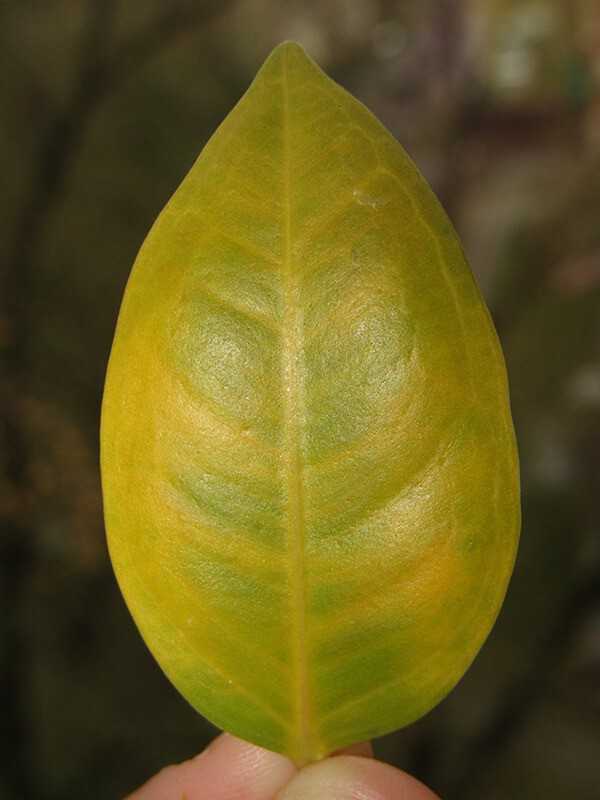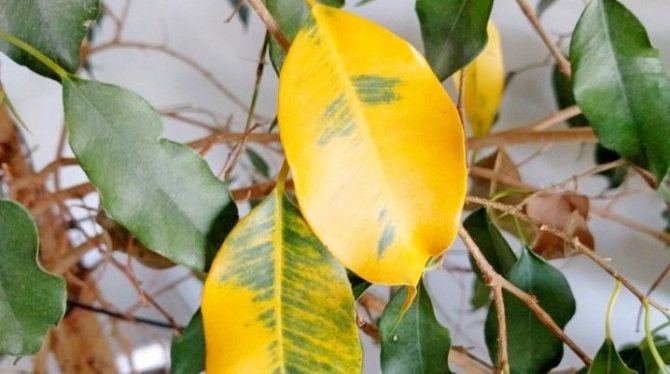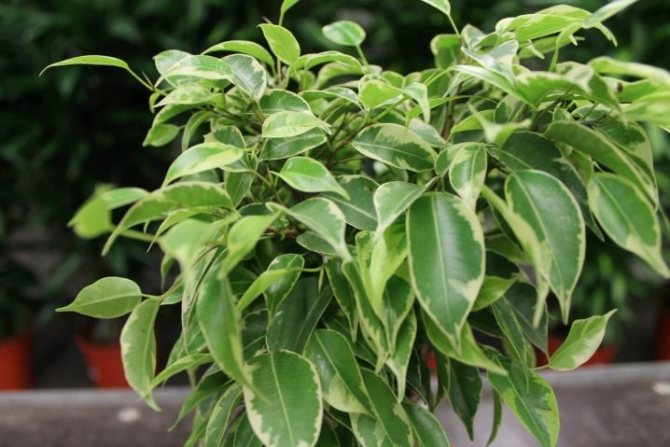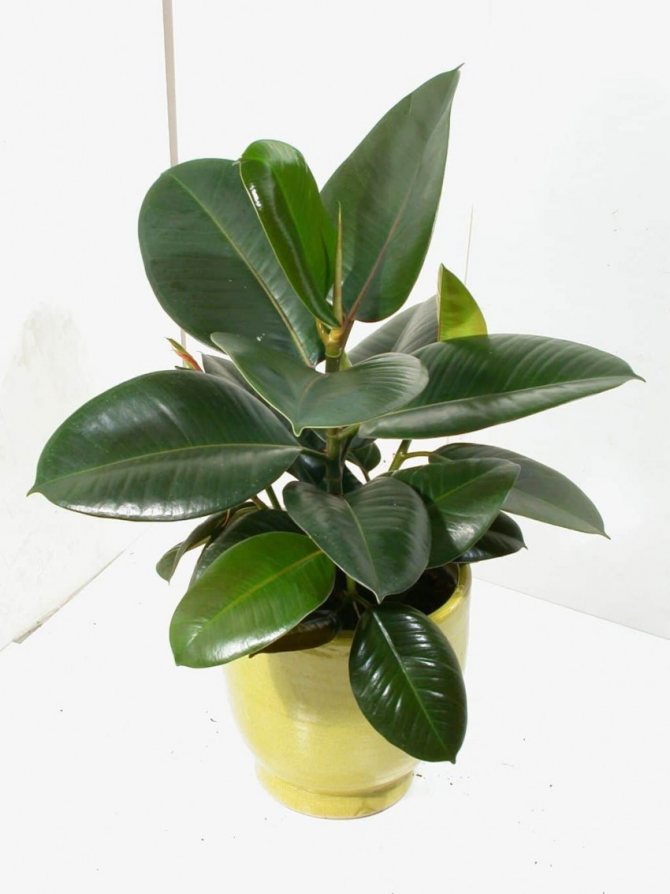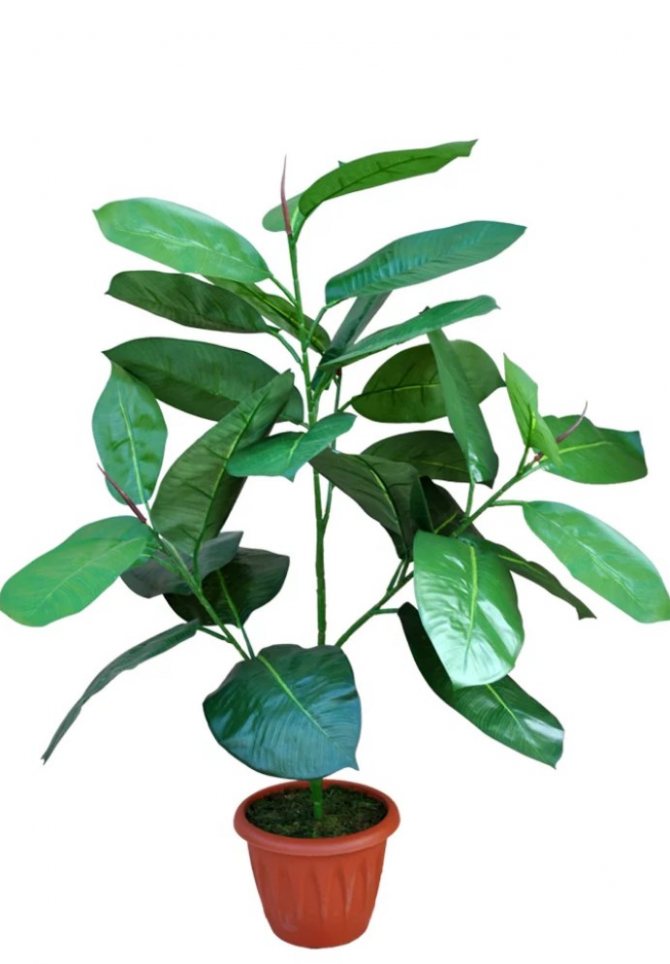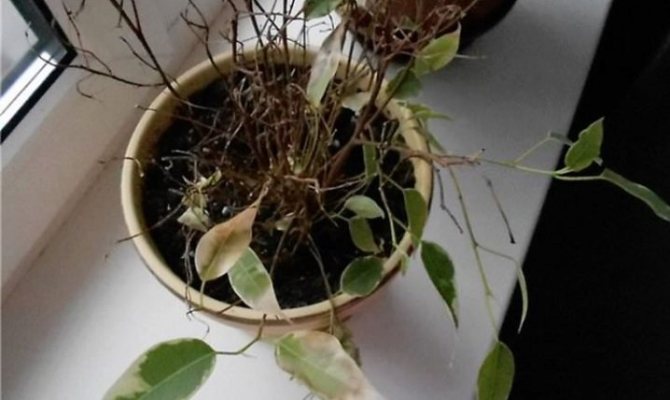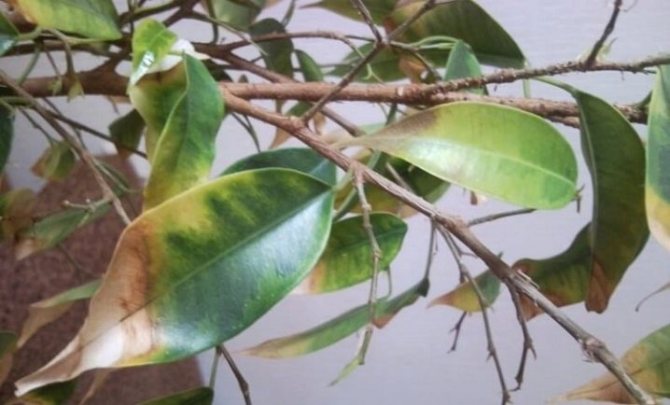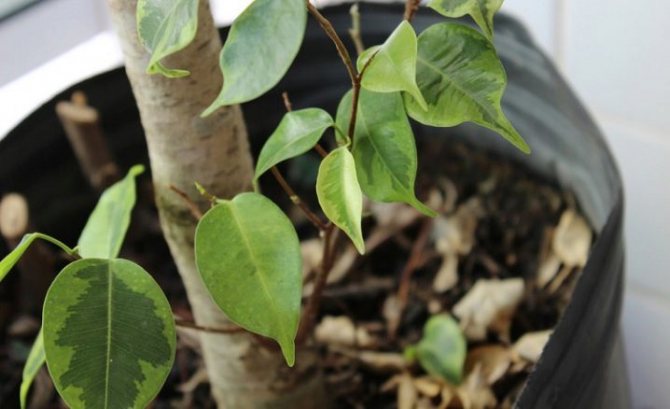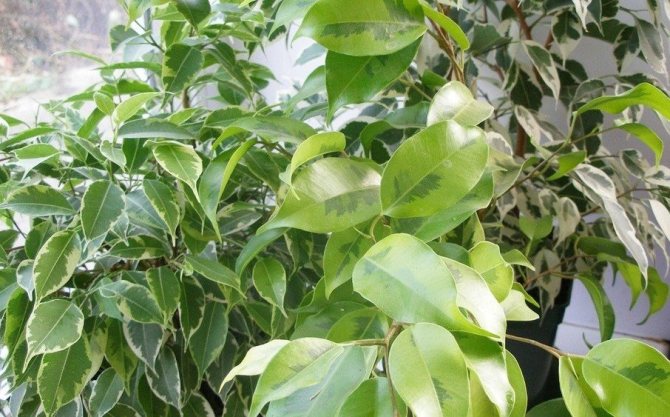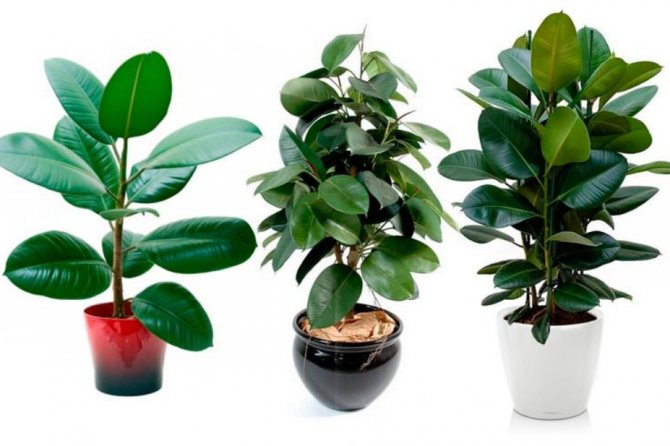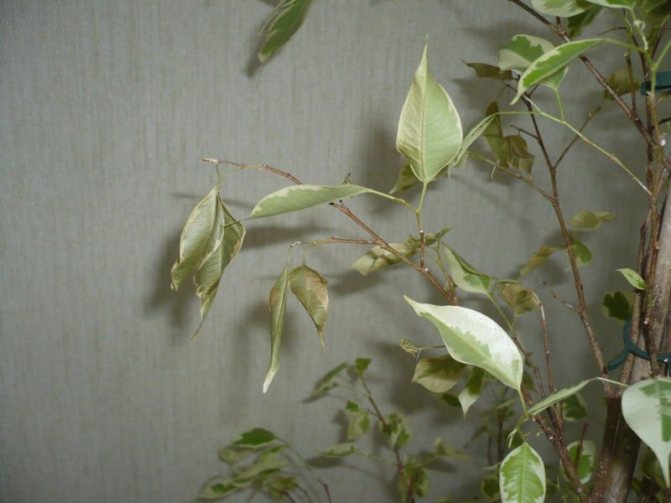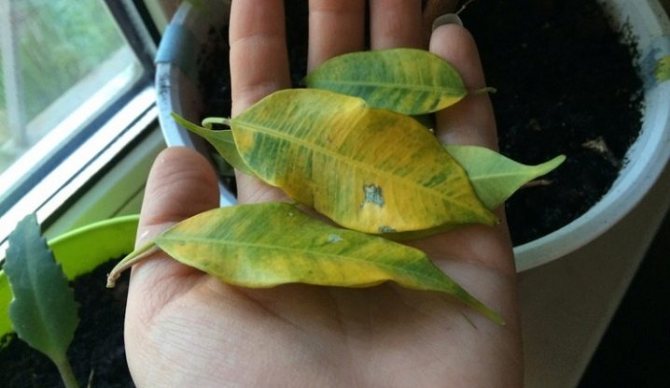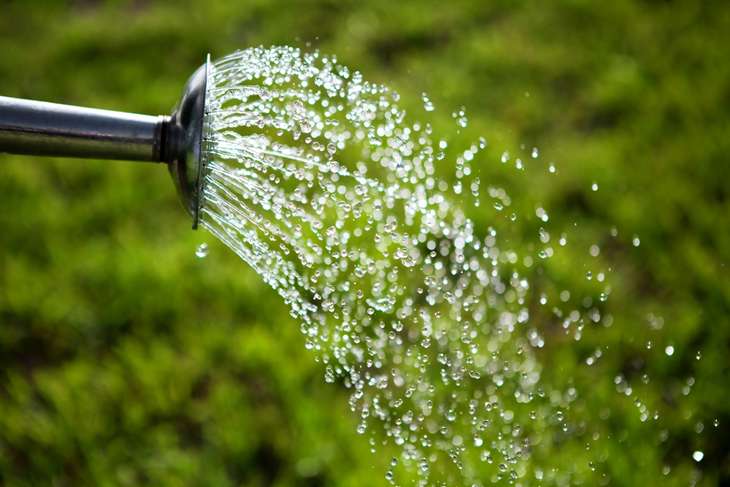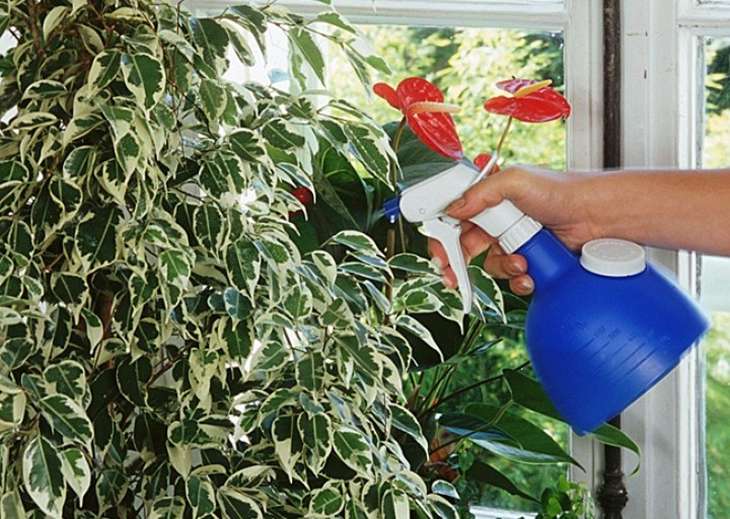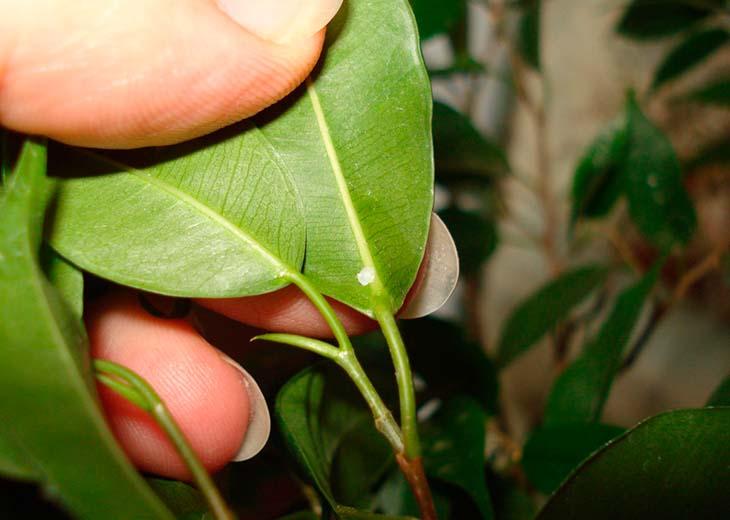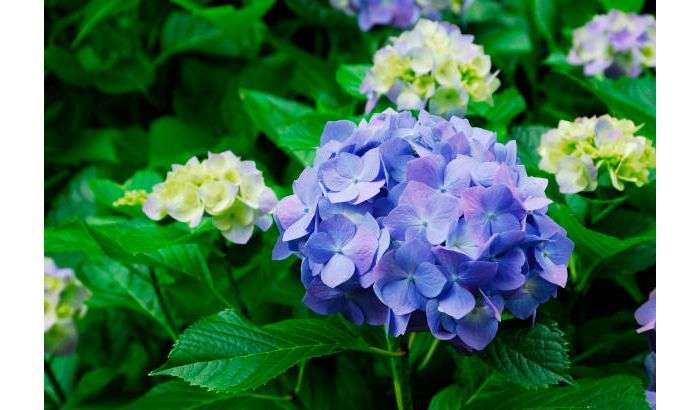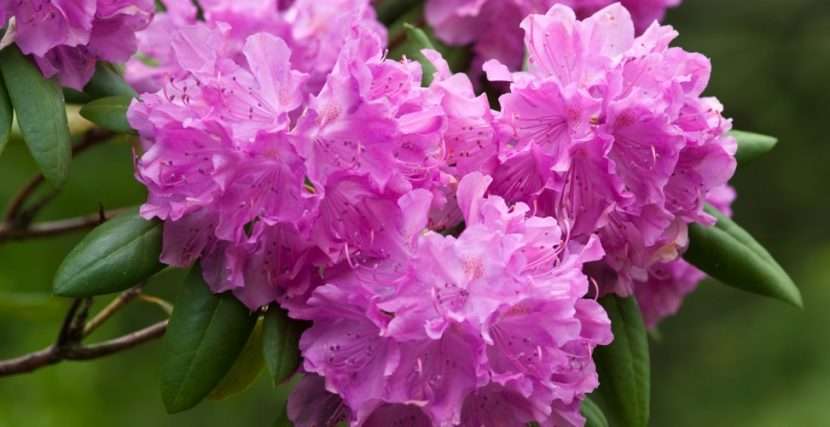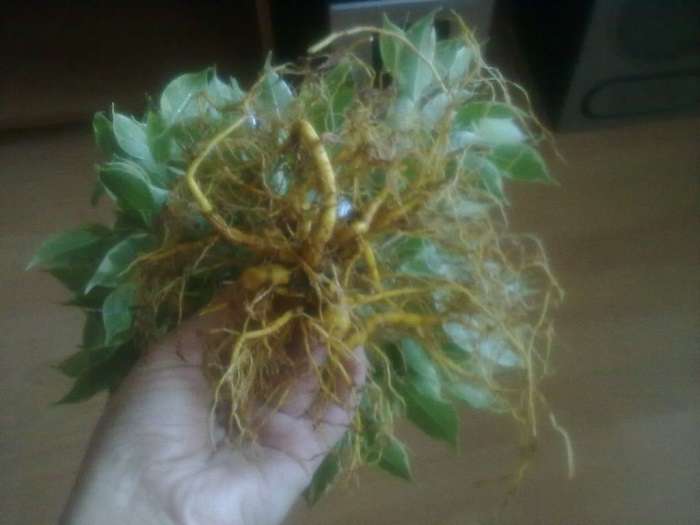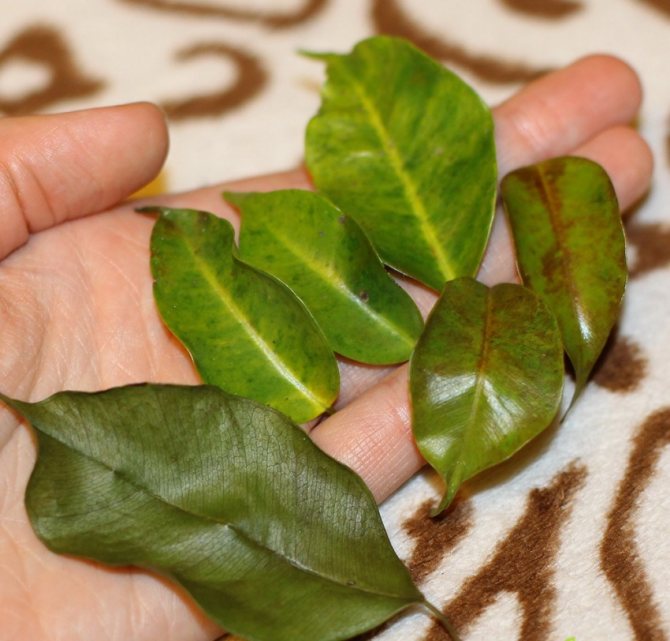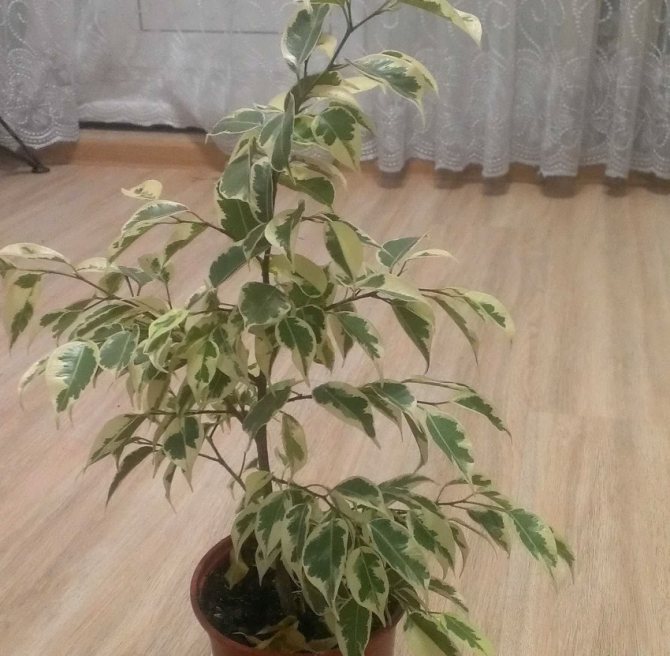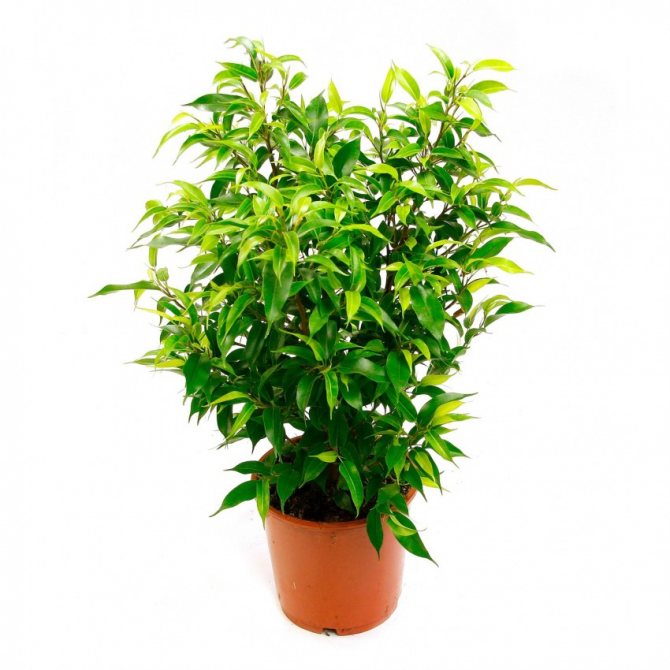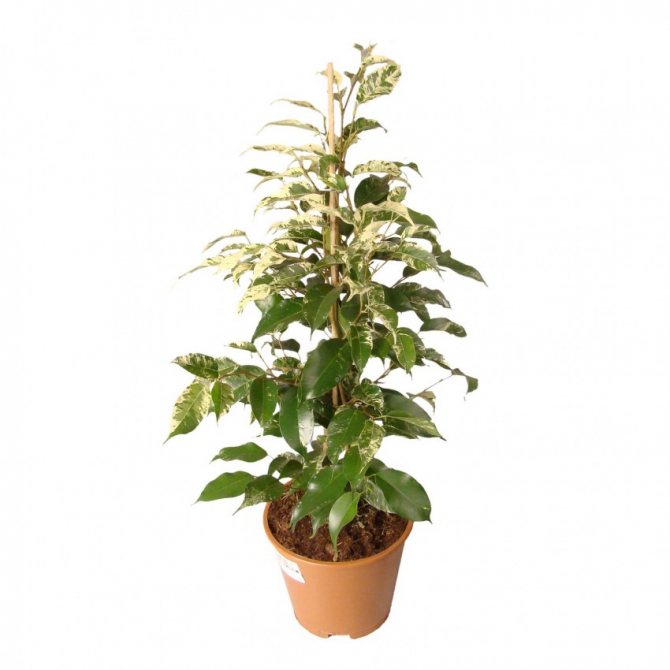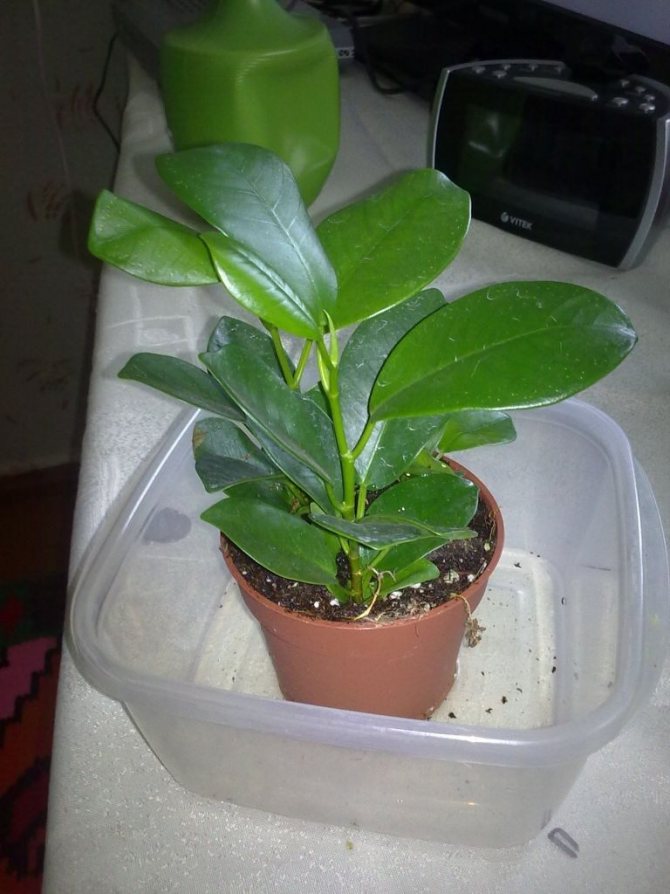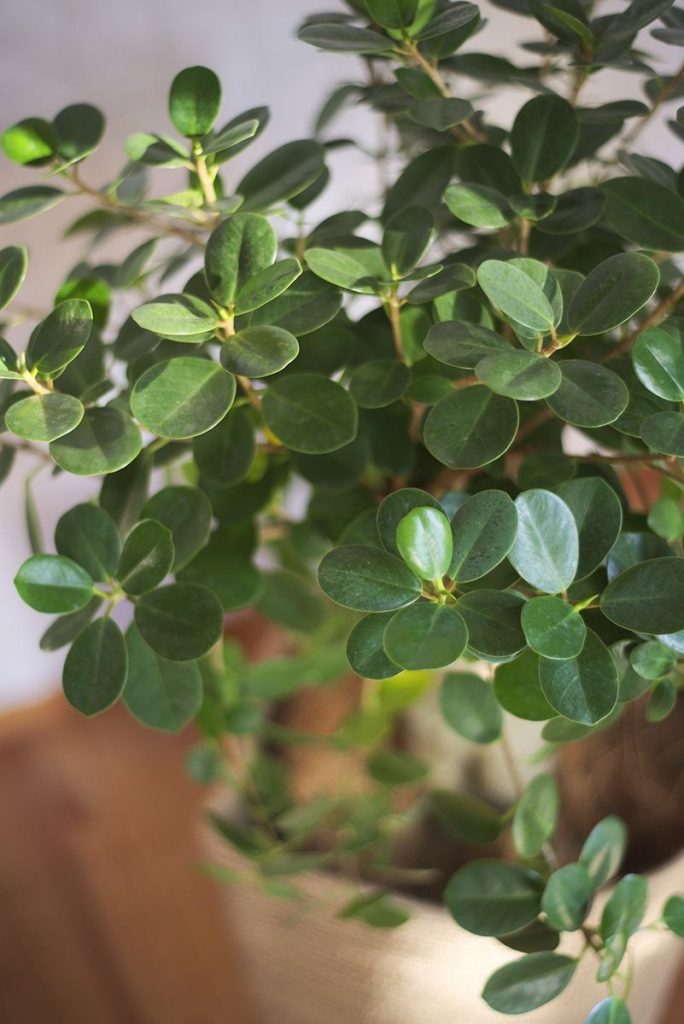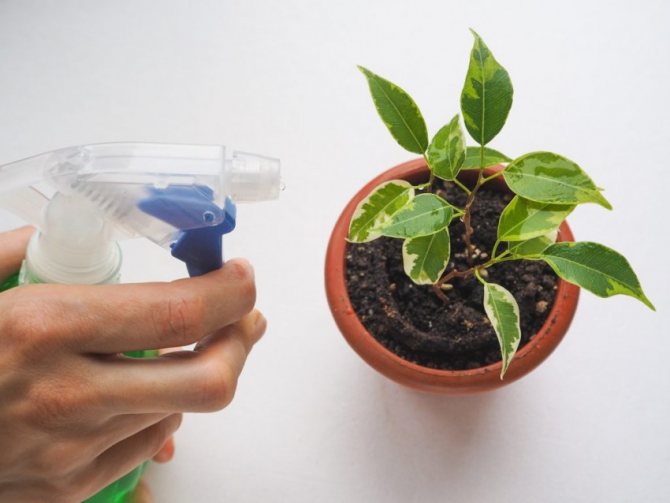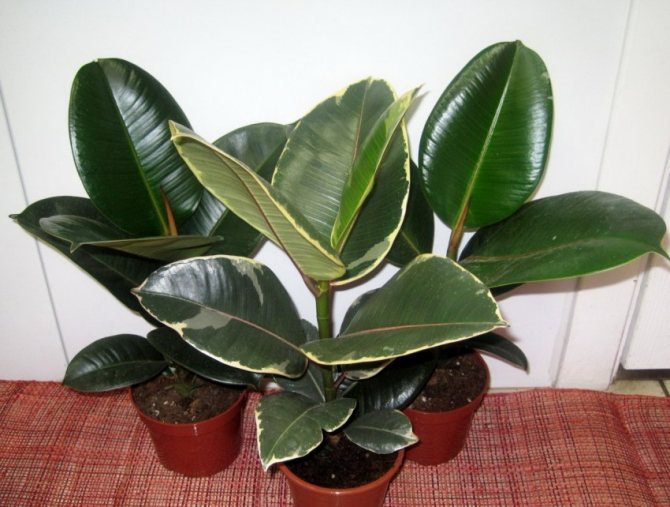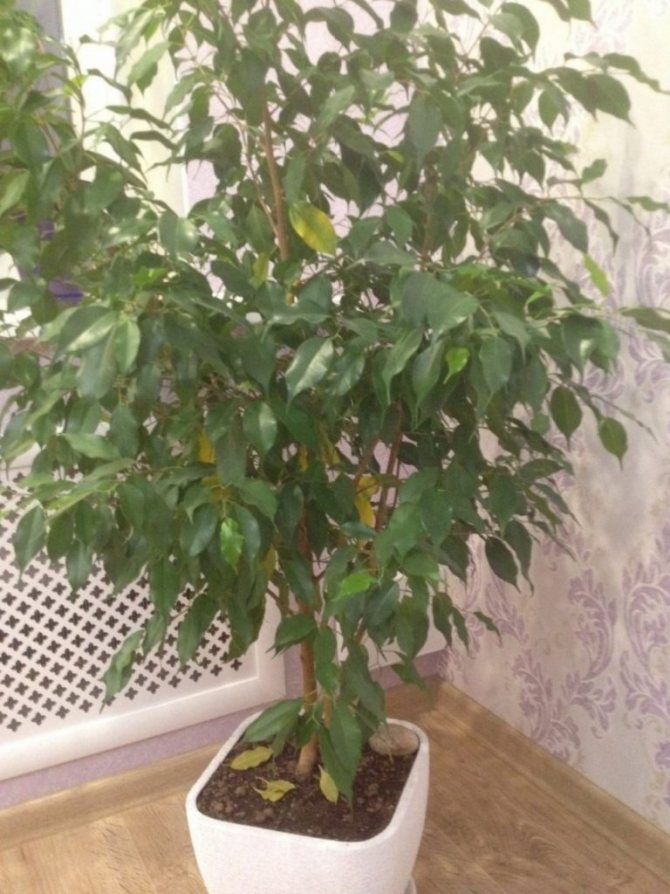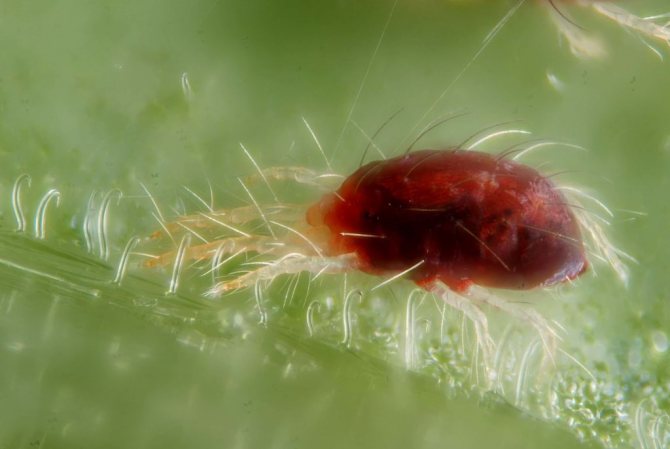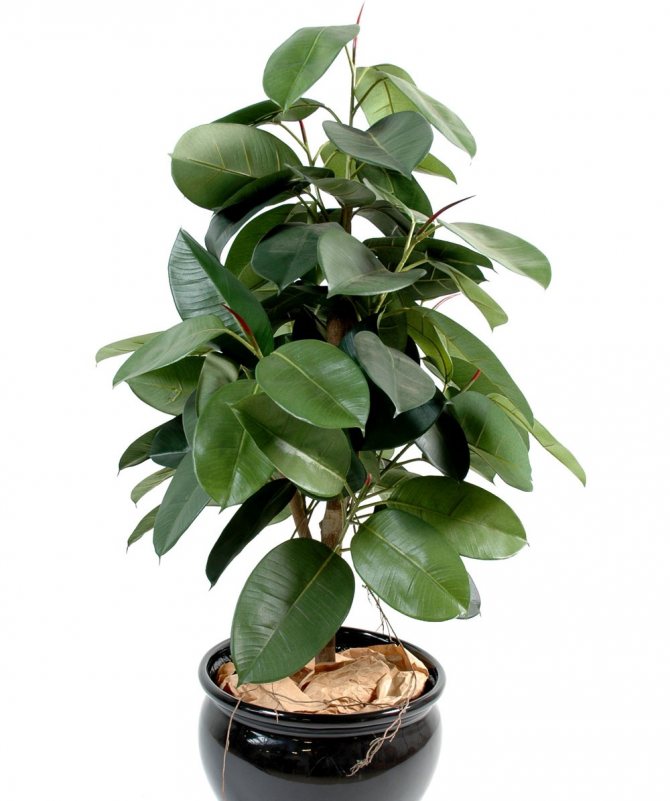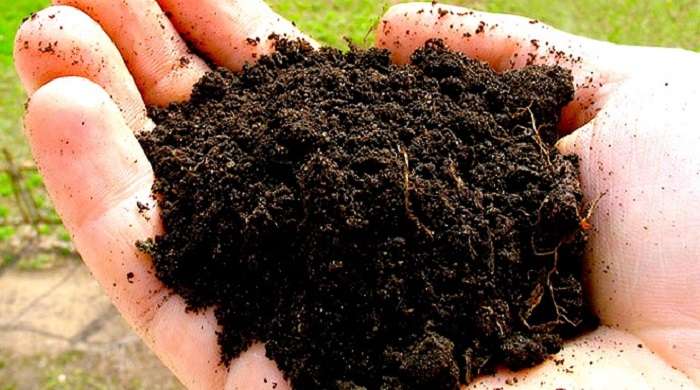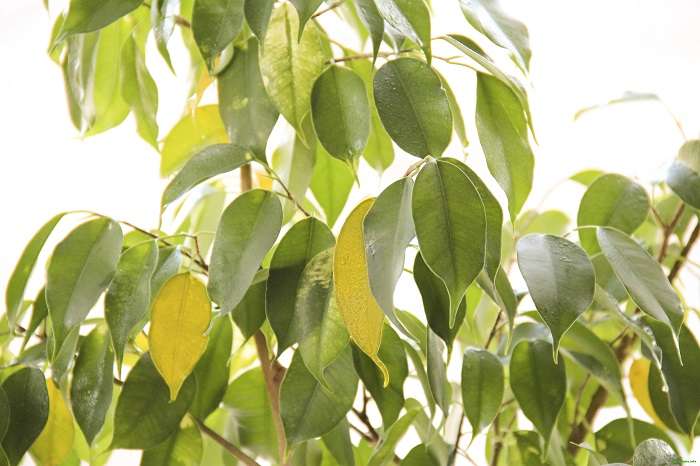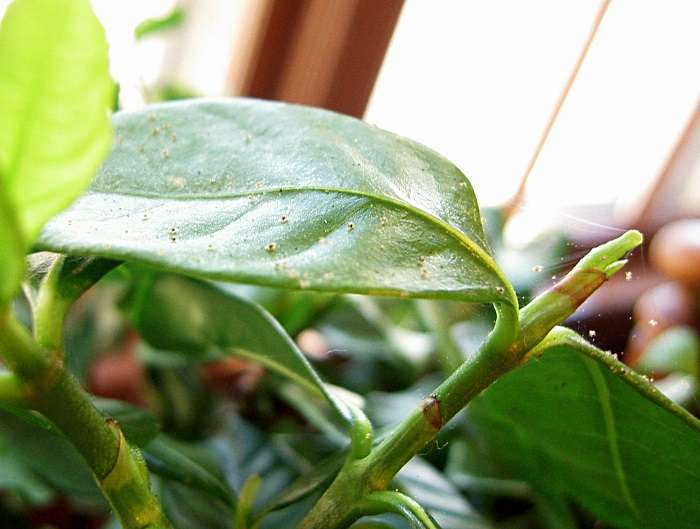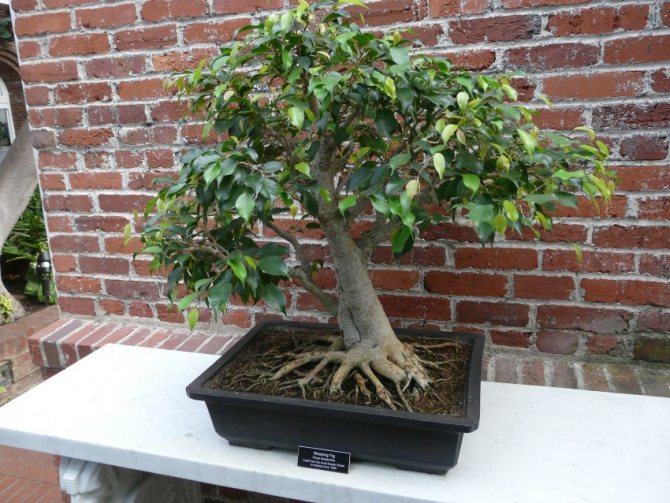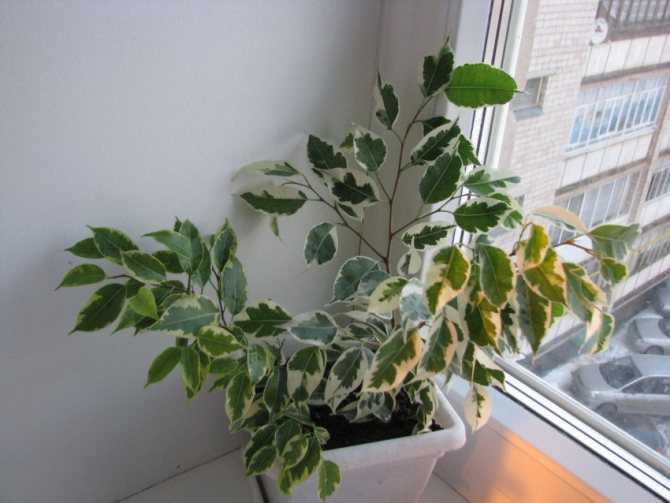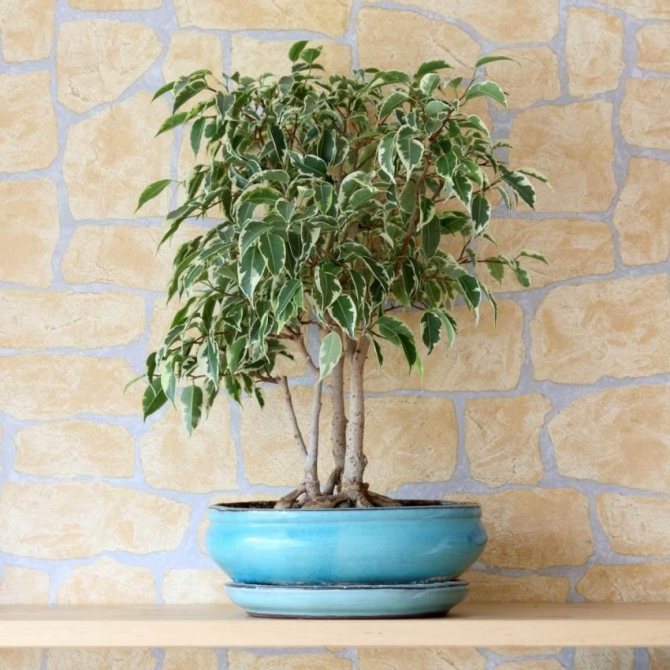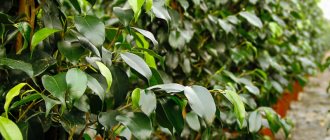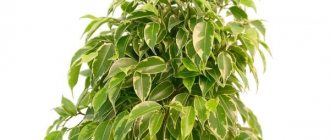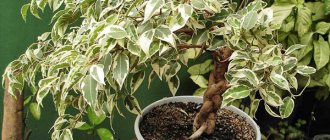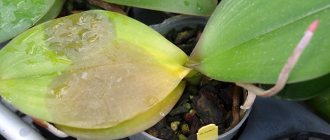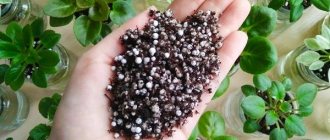Ficus is a rather attractive houseplant that does not require special growing conditions. With proper care, it will be a wonderful decoration for any room. However, situations often arise when the leaves begin to turn yellow and fall off. And if measures are not taken in a timely manner, then the flower may simply die. Within the framework of this article, we will consider in detail, why do ficus leaves turn yellow and fall
and also how to save him.
Under the wrong conditions, the plant reacts almost immediately, dropping foliage. A slight fall of leaves in the autumn-winter period is quite natural, so you should not worry too much. But if there is a massive yellowing and falling off, then you should immediately take drastic measures to save it.
Features of the
All ficuses are amazing plants, they are distributed all over the world. There are about a thousand varieties of this indoor flower, but among them Benjamin's ficus stands out. This plant attracts with excellent decorative features: variegated colors, glossy leaves that form a neat, well-formed crown. Ficus Benjamin grows relatively slowly, does not stretch and always looks presentable.
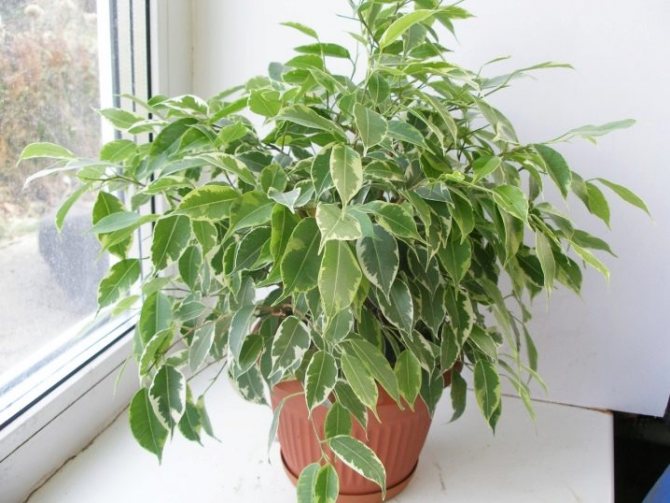
The plant cannot be called particularly capricious., and yet some conditions in the process of its maintenance must be respected. If Benjamin's ficus doesn't like something, then its green leaves will turn yellow and fall off, leaving the branches of the ficus bare.
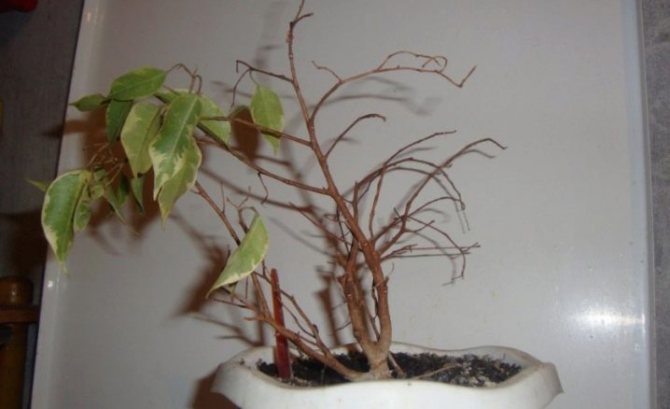

Such a nuisance can be associated with various factors.that require a quick response and prompt elimination. In this case, it will still be possible to revive the flower and return it to its former beauty. In this article, we will find out why Benjamin's ficus leaves turn yellow and fall off and how you can fix this situation. We will also study preventive measures so that this problem does not arise in the future.
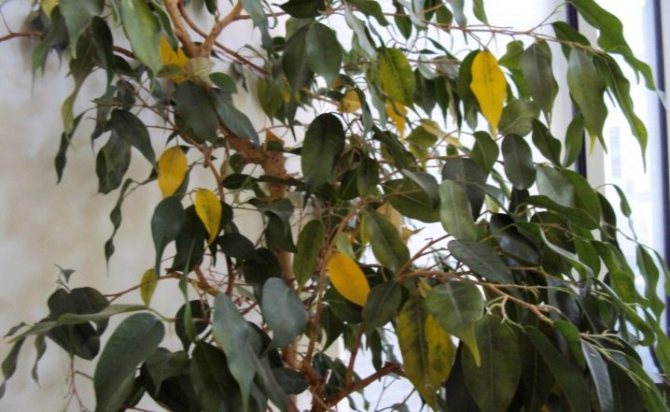

Causes of foliage loss in some species
In different types of ficuses, different causes of foliage can be traced. It depends on how exactly you need to care for the plant.
Ficus Benjamin
The reason for the yellowing and falling of the leaves in the Benjamin ficus can be:
- A change in the usual conditions of detention, since this species does not tolerate changes in conditions, temperature jumps, a decrease in the light regime. Moving the ficus Benjamin from his usual warm place to a colder one will become an occasion for him to drop leaves.
- Sudden changes in temperature and hypothermia as a result of contact with cold window glass or placing a flower container on a cold ceramic surface, so the place for the pot is chosen so that the leaves do not freeze.
- Unfavorable conditions: an overabundance of light, excessively dry air, overdried soil, leading to the appearance of yellow spots and yellow edges on the leaves.
- An imbalance in top dressing: a lack of micro- and macroelements, as well as oversaturation of the soil with fertilizers.
The natural process of replacing foliage with Benjamin's ficus occurs not only in the autumn period. The foliage of this species can fall off during the winter, losing its crown by 10-20%.If the indoor flower begins to lose foliage every day, it is worth analyzing its watering and sufficient illumination.
Rubbery species
This ficus is the most stable and withstands almost any conditions of maintenance and care, however, it may also have reasons to shed its leaves, including:
- waterlogging of soil and stagnant water,
- insufficient lighting in the room,
- excessive fertilization of the earth with dressings,
- low temperatures and the presence of drafts.
Another reason why rubbery ficus can shed its leaves is a flower pot that is not suitable for it. If a pot that slightly embarrasses him is more suitable for Benjamin's indoor flower, the rubber-bearing species prefers freedom, therefore the container for growing it should be larger in size, not restricting the plant, otherwise its leaves begin to shrink in size and fall off after a while.
The reasons
Let's not rush to analyze the reasons that Benjamin's ficus strongly discards leaves. First, we want to draw attention to the fact that a small amount of foliage can fall off in autumn or winter for no reason. Usually this process starts in November, but deviations in both directions are possible. The number of discarded leaves will vary within 10 pieces.
This situation is the norm, therefore, you should not worry and take urgent measures. With the onset of spring, new foliage will appear in place of the fallen specimens, and in the summer the plant will be lush and even more beautiful.
If the opal is more than 10 leaves, then you can already start worrying about the state of your favorite plant.
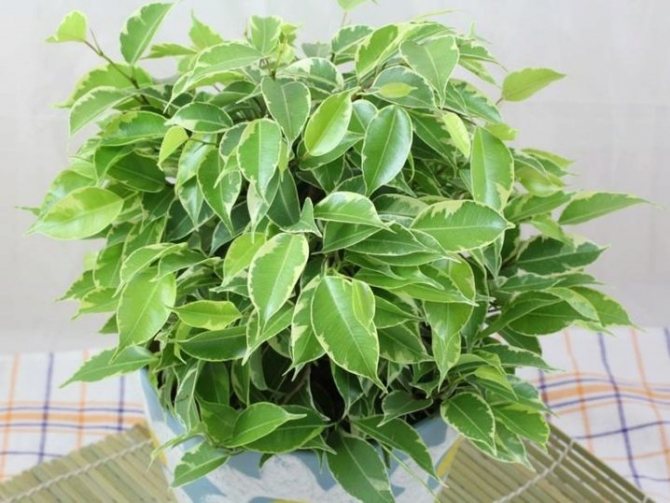

The ficus begins to voluntarily part with the leaves only after the sixth year of life. Up to this point, old foliage is essential for the plant, as it plays an important role in the processes of photosynthesis. Therefore, for no apparent reason, the room "resident" will not part with any of his leaves.
Lower leaves can fly naturally. If the foliage is not enough at the top, it means that the plant could not absorb and accumulate the required amount of the necessary trace elements. Therefore, excess foliage flies from the ficus, for the maintenance of which the plant does not have enough strength. This situation is not critical, but for the grower it should serve as a signal that will indicate about insufficient feeding.
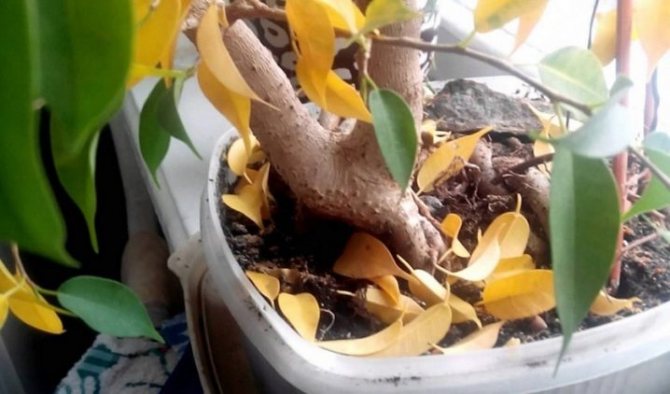

Diseases
Ficus Benjamin is highly resistant to various kinds of diseases and pests. And yet, on rare occasions, it is for these reasons that it can shed its foliage. This plant is characterized by diseases of fungal origin: anthracnose and cercospora. They appear as spots on the leaves. As the infection progresses, the affected leaves turn yellow, dry and fall off.
Such diseases must be treated, otherwise the plant may disappear completely and even infect its neighbors.
The essence of the treatment is to remove the affected leaf plates and treat the plant with fungicides in accordance with the instructions for use.
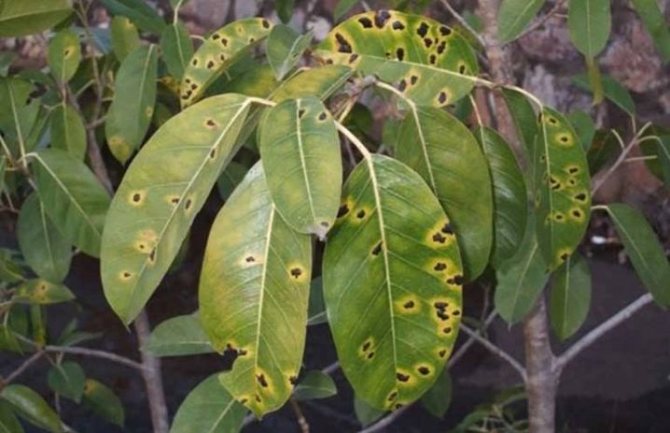

Pests
From pests on ficus can settle spider mites, scale insects and thrips... The first problem is identified by the thin cobweb that envelops the young leaves. In a neglected state, not only the leaves become dry, but also the tips of the shoots. In specialized stores, many drugs are sold to combat spider mites.
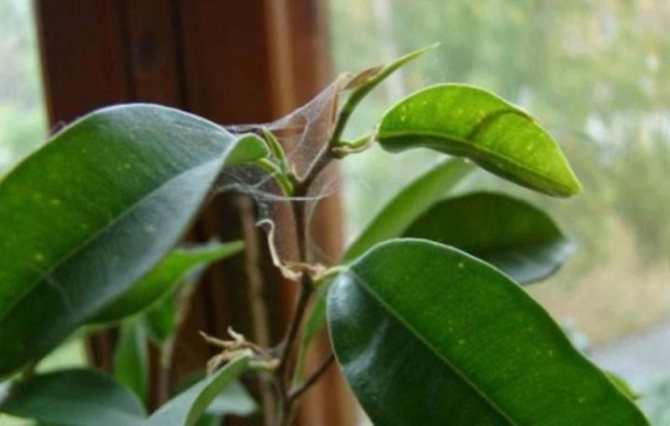

Thrips actively reproduce on ficuses and quickly switch to healthy plants. It is difficult to fight this pest, but it is necessary, because after a short time, traces of infection can be found on all flowers in the house. The thrips are located on the back of the leaf plate.None of the folk methods are able to completely rid the flower of this pest. Only the use of insecticides will cure the houseplant.
Re-processing should be carried out in a week, since young individuals appear from the eggs, which can be found not only on the plant, but also in the ground.


Shield well known to every grower, as it is often found on deciduous house plants. Mostly this pest is introduced into the house with new flowers purchased from specialized stores. It is also difficult to fight the scabbard, since adults are covered with a shell, which complicates the process of processing with special preparations. Adults feed on plant sap, which causes irreparable harm to leaves and even shoots.
The shield must be removed from the plant with a sponge and soap solution, followed by treatment with insecticides.
Temperature regime
Ficus Benjamin will develop normally at a temperature of 18 to 25 degrees... At higher temperatures, the leaves will become lethargic, yellow will appear, and over time they will fall off. In a cooler room, the plant will stop developing, the root system will experience hypothermia, which will start processes that will negatively affect the state of the crown.
The situation can be aggravated by the location of the flower on a cold windowsill, concrete or marble floor. Drafts also negatively affect the condition of the plant.
To prevent Benjamin's ficus from shedding foliage, it is necessary to carefully select a place for installing the pot and monitor the temperature in the room.
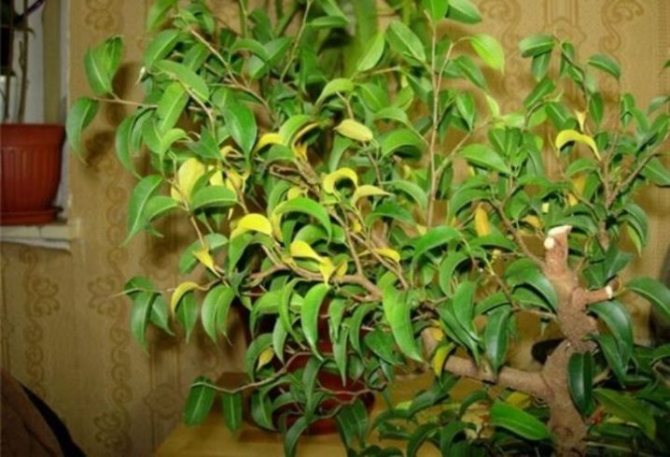

Watering
Often, due to errors in watering, the plant loses its beauty and loses its leaves. To preserve the flower and help it quickly recover, it is necessary to calculate the water rate for each watering and constantly monitor the soil moisture level. Our tips will help with this:
- between waterings, the soil should dry out 1.5 cm deep; for an adult flower, the drying depth can increase to 3 cm;
- in winter, the frequency of watering is reduced to once every 7 days;
- water intended for irrigation must be warm;
- the frequency of watering directly depends on the air temperature in the room (the warmer, the more often).
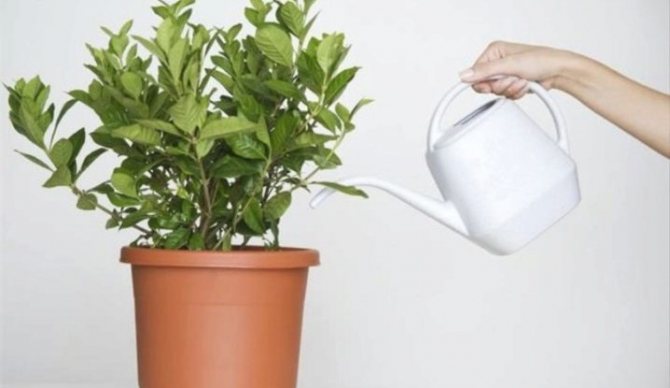

With an excess of water, the ficus can suffer from root rot. The flower will become weak and may shed its crown. It is difficult to fight root rot, and the plant can only be saved in rare cases. All damaged roots must be removed, and the remaining root system is placed in a weakly concentrated solution of potassium permanganate.
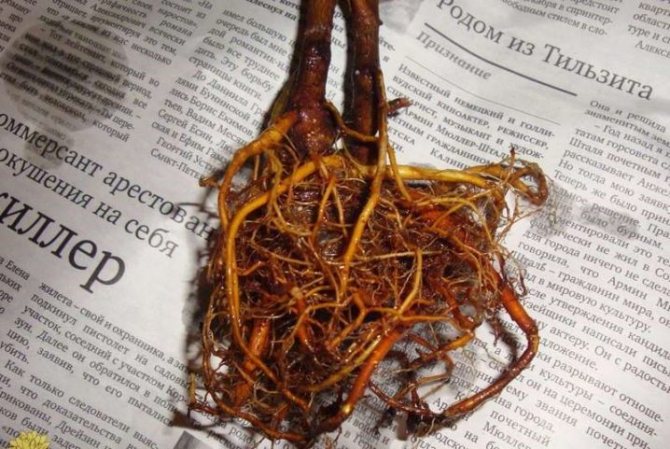

With a lack of water, the plant will tend to preserve the roots and its woody part, which will also lead to shedding of foliage. If you restore the water balance and bring the watering process back to normal, the plant will recover, however, this will take some time.
Incorrect transplant
It also happens that the flower, after transplanting, began to shed its foliage. Then we can confidently talk about the violations committed in this process. Ficus Benjamin transplant should be carried out every two years... This period is considered optimal, since the plant just manages to braid the earthy ball with its roots and deplete it.
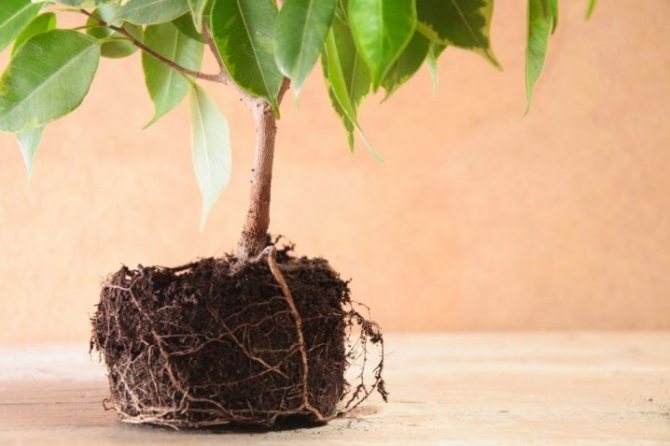

The process of transplanting ficus Benjamin is carried out in accordance with the following rules:
- a new pot is being prepared, which should differ slightly in size from the previous one (by 3 cm in diameter and 5 cm in height);
- carefully and carefully, the flower is removed from the pot;
- the excess earth is shaken off;
- in a pot intended for planting, the bottom is covered with drainage material, a layer of earth is poured on top;
- the plant is placed in a prepared pot, which in its dimensions will correspond to the size of the flower;
- the free space around the root system of the plant is covered with prepared soil, lightly compacted and watered;
- after a while the earth will settle, therefore you will need to add soil to the pot.
Diseases
There are many different diseases that can provoke changes in the color of the leaves of a plant. Basically, these are fungal diseases that appear in the case of abundant watering, improperly chosen plant care, mistakes made during flower transplantation.
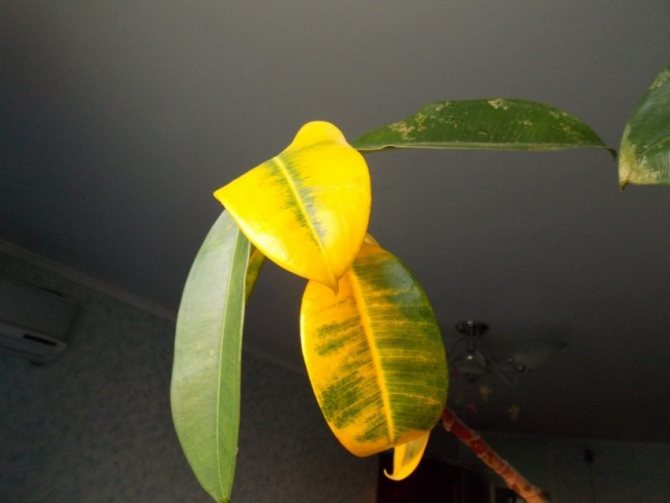

As soon as you notice the first signs of fungal damage to the plant, it is imperative to treat it with fungicides used for indoor plants.
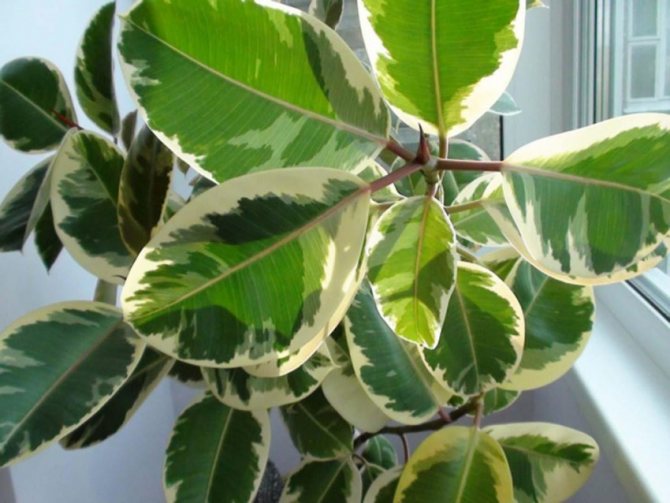

How to fix it?
To save the plant and help it cope with the problem, it is necessary to react quickly and not start an already problematic situation. Next, we will talk about what to do with a plant that gets rid of foliage.
Initially, the essence of the problem is determined, and only after that appropriate measures are taken for salvation.
It is necessary to consistently study all the reasons due to which the plant disappears. First of all, pests are checked and diseases are detected, then you can proceed to the analysis of watering and conditions of detention (air humidity, dry soil, drafts, room temperature). Using the method of elimination, we find the real reason and are engaged in its elimination.
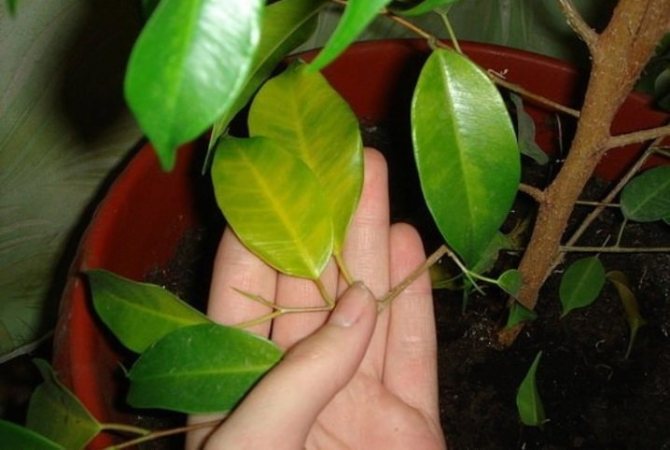

Below are tips to help cure the plant, and will allow the ficus to return to its former beauty in a relatively short time.
- When pests are detected or diseases, tough measures are taken to eliminate them, the affected foliage can, or rather, must be cut off. Don't forget to look at other indoor plants.
- In many cases, the actual solution is a ficus transplant. It is important to make a good soil in compliance with all proportions. Transplanting should be carried out by the transshipment method, in this case, the acclimatization time will be shortened, and the plant will not hurt.
- After fixing the problem the plant needs to provide enhanced feeding. Fertilization will allow you to quickly restore the ficus, the plant will get stronger, you will notice how its shoots harden day by day. The restored ficus can continue to delight the eye with rich glossy foliage.
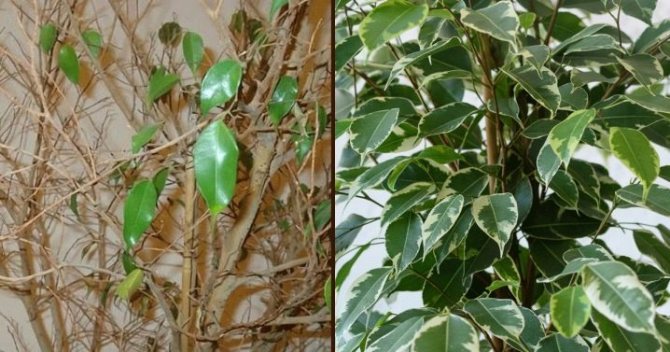

If everything is done correctly and in a timely manner, after a short time, new leaves of the correct shape and the desired color will grow on the shoots. To fully reanimate Benjamin's ficus will take effort and time - it won't be easy. But in the future, the plant will thank for its care with a lush crown, intensive growth and a gorgeous appearance.
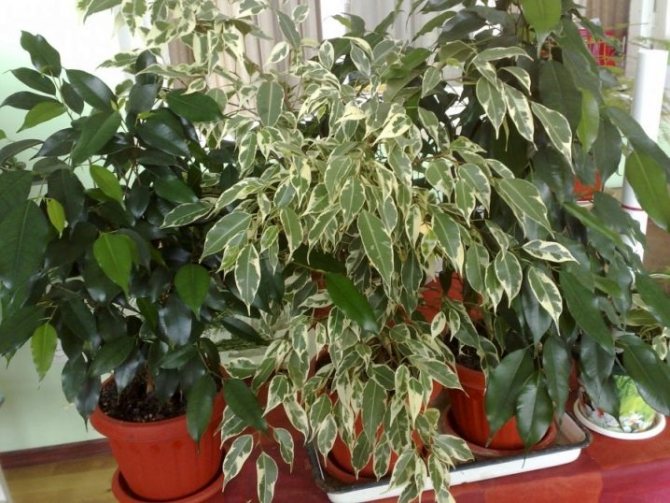

Initial measures


The flower can be saved
When asked what to do if the leaves of the ficus are falling, most flower growers advise to find out exactly the cause of this process and eliminate it by arranging proper care.
If parasites are detected and signs of a fungal infection are present, immediate measures are taken to save the flower:
- At the initial stage of the development of the ficus disease, the affected areas of the plant are cut off, and the remaining intact foliage is cleaned of pests and mold spots with a soft brush, rinsing with running water.
- Disinfection is carried out by treating the stem and leaves with garlic infusion made from 60-80 g of garlic, infused in a liter of boiling water for an hour. The procedure is carried out daily until the problem with the foliage is completely eliminated.
- As a disinfection, soap-alcohol mixtures can be used, for the creation of which laundry soap is mixed with a spoonful of alcohol in equal proportions, the ficus is sprayed with this solution at intervals of 4 days and followed by washing the leaves after 12 hours. The full course of treatment is 2 weeks.
- Treatment of an indoor flower from shedding leaves can be carried out using specialized products designed to combat parasites and fungal infections of plants.
Prevention measures
So that leaf fall never darkens the joy of growing Benjamin's ficus, it is necessary to follow simple rules of care and preventive measures:
- in winter, watering is reduced to once a week;
- at a room temperature of about 10 degrees, irrigation of the land is not carried out;
- the air temperature in the room is kept within the range of 20-25 degrees throughout the year, except for winter time, for this period 16 degrees will be considered the norm;
- leaves must be constantly sprayed or wiped with a damp cloth;
- for the location of the flower, it is necessary to choose a bright room without direct sunlight and drafts, the east side would be the best option;
- watering should be moderate, but frequent, using warm water;
- it is better to choose the spring period for transplanting, it will be easier for the plant to go through the acclimatization stage;
- before each watering, the soil must be loosened, which will avoid stagnant water and ensure its even distribution;
- fertilizer is applied as needed, it is better to feed less often, but better;
- the mixture for planting must be taken fresh and of high quality.
Caring for Benjamin's ficus at home cannot be called difficult, and yet this flower is demanding on the conditions of detention. If you provide this plant with the necessary conditions, it will delight with juicy, bright foliage and a spreading crown.
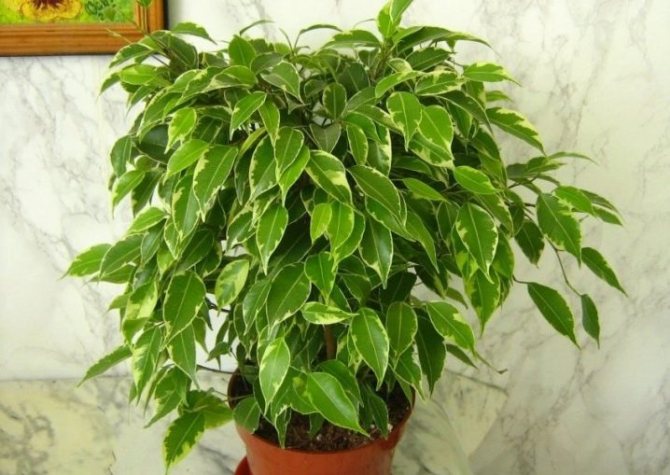

The reasons for the leaves of the Benjamin ficus and how to eliminate them can be found in the following video.
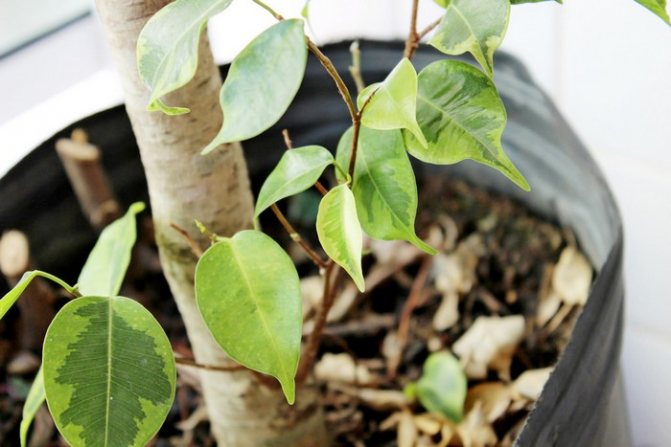

Ficus Benjamin is one of the most popular indoor plants. Ficus is easy to care for at home, cultivation should not bring difficulties even to novice indoor plant lovers. But sometimes the ficus begins to shed its leaves, occurs when the tree has undergone stress. Find out why Benjamin's ficus sheds leaves, how to prevent leaf fall.
Ficuses, aka figs, are popular houseplants. Most often, the ficus Benjamina (Ficus benjamina) is grown at home, called weeping, because it has slightly hanging shoots. It has shiny, leathery leaves, covered with a waxy bloom, the length does not exceed 8 cm, the width is 2.5 cm. Indoors it can grow up to several meters in height.
Ficus Benjamin is a plant with small and leathery leaves that perfectly cleanses the air from almost all toxins: ammonia, formaldehyde or benzene.
Ficus Benjamin is easy to grow, beginner friendly, popular and readily available. He loves a lighted place, moderate watering, fertilizing - every 2 weeks and cleaning the leaves from dust.
Ficus Benjamin, once purchased and delivered home, may take several months to a year to adjust to a new location. Over time, it can grow poorly, can be attacked by pests. After acclimatization in a new place, the above problems disappear.
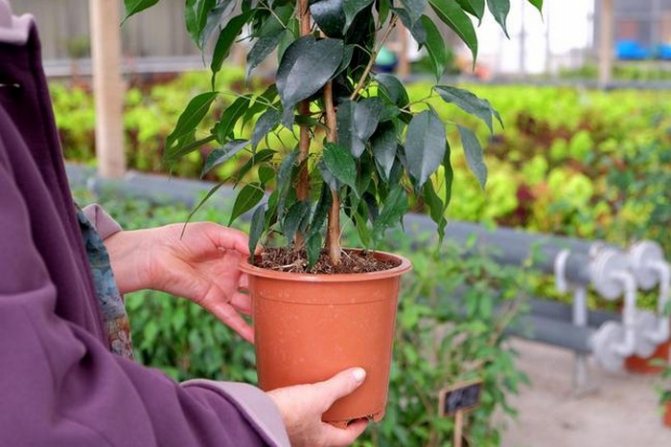

Leaf loss can be caused by:
- insufficient supply of mineral components;
- water scarcity;
- fungal pathogens;
- ficus mosaic virus;
- inadequate watering.
Home care
In order for the ficus to grow correctly and delight with its green leaves for many years, it is important to create optimal conditions for it.
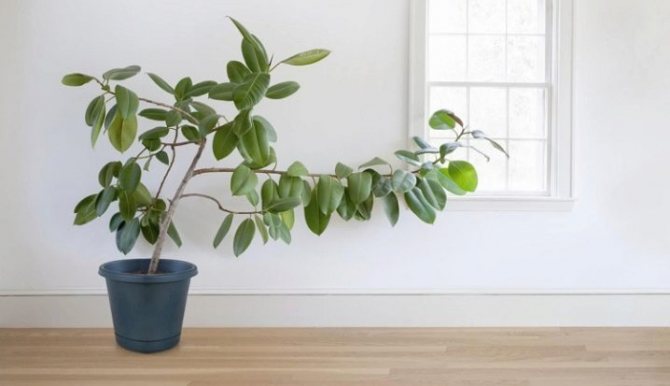

Correct and sufficient lighting
Due to the tropical origin of the plant, the most important factor for it is the presence of a large amount of light. Since there is a certain species diversity, the conditions of their maintenance may differ slightly.
Those variants with darker foliage are able to stay longer in shading conditions; for plants with light foliage, light is the most important condition for growth.
Species with variegated leaves can even tolerate direct sunlight, while other options should be hidden in partial shade. In winter, when there is not enough daylight, it is important for the ficus to organize additional lighting. This can be done using a special lamp, which will make it possible to illuminate the bush for at least 12 hours a day.
To make the crown uniform and beautiful, it is worth turning the pot in different directions, exposing the greenery to the light source.


Suitable humidity level
High humidity is common for ficus, but its range should also be kept within certain limits. For good growth of the bush, it is worth spraying it or placing it under the shower. Those varieties that have large leaves must be wiped with a damp cloth, because dust collects on the surface of the leaf plate, which prevents the plant from functioning normally.
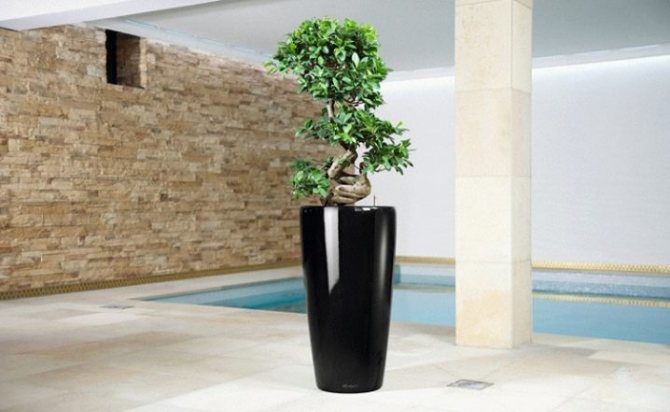

Optimum air temperature
Tropical conditions are the most comfortable for ficus, so keeping it in summer at a temperature of 20-25 degrees, and in winter 15-20 degrees, will be the most optimal. The minimum indicators are 10-15 degrees, at which it is worth removing the plant in a warmer room.
It is very important to protect the ficus from drafts and hypothermia of the soil, which very much affect the general condition of the plant.
It is worth choosing a well-insulated window sill, the window on which will be closed.
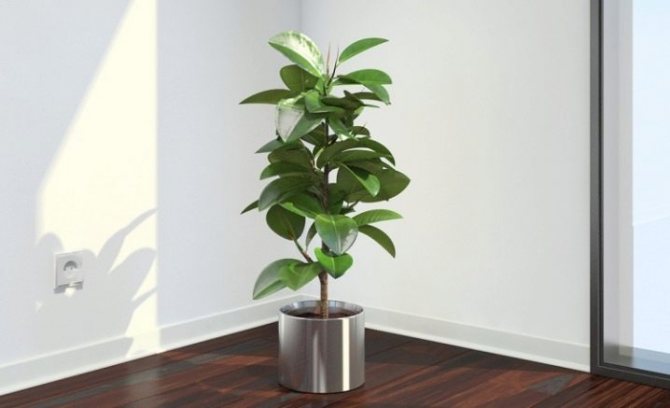

Watering conditions
For different seasons, the amount of moisture applied to the soil will differ. More water is needed in summer, less in winter. The next watering should be done only when the soil is dry, but not completely dry. With a cold snap, watering decreases, since waterlogging of the soil leads to root rot and the development of diseases.
Ampel varieties of ficus need more watering than ordinary ones.
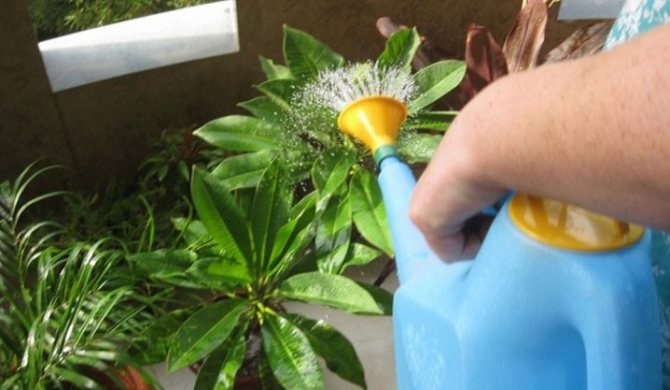

Plant fertilization
It is necessary to apply fertilizers to the pot with ficus when the plant is in active growth. The most suitable time frames for this start in March and end in September. Nutrients are added every two weeks.
The correct composition should contain a large amount of nitrogen, which makes it possible to stimulate the growth of the green part of the bush.


Transfer
The growth of ficuses is quite fast, because every year they need to be transplanted, changing the soil and, if necessary, the pot, or planting the plant. The optimal month for this procedure is March. The pot should not be taken very large, as due to the large amount of soil, growth becomes slower. A drainage layer is necessarily laid out on the bottom.
Ficuses are not very susceptible to diseases, but sometimes spider mites, scale insects or tips can be seen on them, for which it is appropriate to use insecticides.
If the ficus grows in one place and the conditions are completely suitable for it, it is not worth changing anything, measures should be taken only if any problems arise.
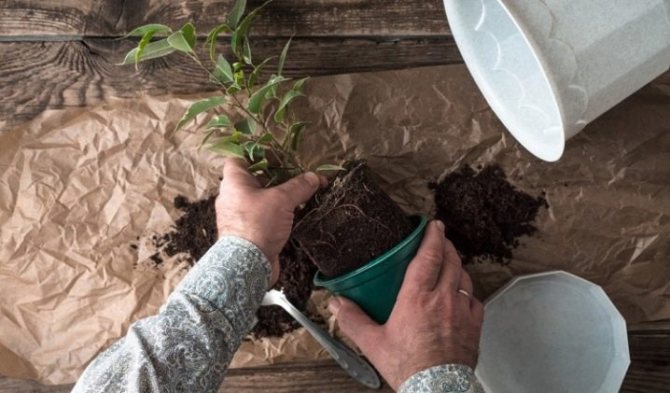

Why does Benjamin's ficus shed its leaves?
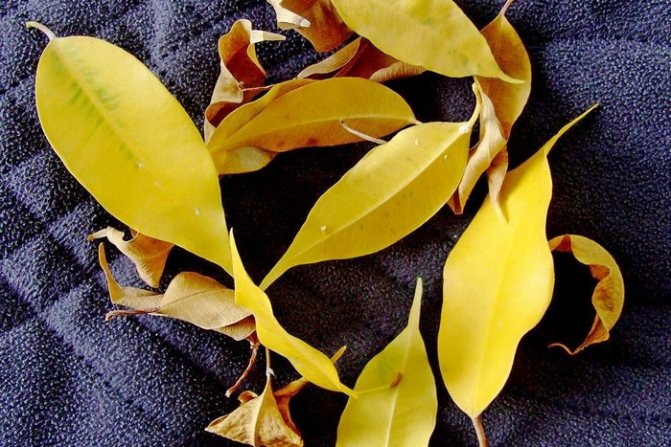

Subsidence reasons:
- Ficus stands far from the window. The plant loves sunny places, but does not grow well in direct sunlight on the south window.
- Permutation. He does not like moving, after a while the plant brought from the store may lose some green leaves. There is no need to be afraid, in a new place it will create a lot of new increments.
- Too cold or too hot. The optimum temperature for Benjamin Ficus is 20-24 ° C, the temperature should never drop below 13-15 ° C. When the pot is too close to the radiator, sensitive to drafts, it should not be placed next to an open window or in a hallway where doors are often opened.
- The substrate is too wet or too dry. Watering ficuses is an art. Do not water until the surface of the ground is slightly dry. Plants like to water it moderately so that the soil in the pot is always slightly damp.
- Fertilizer.Plants are fertilized regularly during the season once every 2 weeks - better with a universal mineral fertilizer alternating with organic fertilizers.
- Growing too long in the same land. Plants brought home are immediately transplanted into a new, larger pot, peat soil in a small pot, will not provide enough nutrients for growth. Use a universal potting soil or a long-term fertilizing substrate. Later, the plants are transplanted every year, old specimens every 2-3 years. When the ficus is large and growing in a large and heavy pot, we change the topsoil every year.
- Dust. The ficus needs a shower every two weeks. The plant along with the pot is watered under the shower with warm water.
- The plant is weakened by the attack of pests or disease. Ficuses are often attacked by false scutes (brown scutes) and spider mites (small red spiders). Pests can be dealt with, for example, with Aktellik. Diseases (rot and mold) are more likely to occur with over-watering. Limit watering and change the top layer of the earth. If symptoms persist, it is necessary to use protective equipment - for example, Baymat Ultra, protects ornamental plants against various diseases.
What to do and how to prevent falling
So, the natural reason why the ficus sheds leaves is seasonal leaf fall. In this case, you just need to continue caring for the plant. If the fall is not seasonal, then you need to immediately look for the cause in order to immediately tackle it. Let's start with preventive measures that will not allow the flower to wither and die:
- The flowers should have a permanent place of residence: decide right away where the pot will stand, and do not transfer it if possible.
- For ficuses, temperature and sufficient humidity are important. Keep track of these indicators, and the leaves will always be green and healthy.
- The pot must have good drainage. Water in moderation.
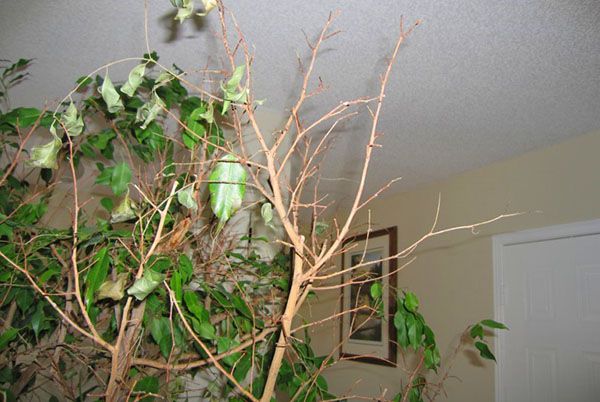

The question "Why do the leaves turn yellow?" occurs even among those flower growers who carry out all preventive measures in good faith.
If the ficus dries anyway and, perhaps, even threw off all the leaves, then we need to look deeper - it looks like the root system has rotted. In general, the ficus must be monitored constantly. Remove the plant from the pot, examine the roots. They resemble gray threads, and even slippery - it means that the problem lurked here. How to revive and is it possible to do it at all? Yes! To do this, you need to do the following: cut off dead roots and dried leaves. Now we soak the root system in a weak solution of potassium permanganate. Let the cut dry and plant the plant in dry ground. Water in moderation for the first few days.
If the leaves of the ficus dry, turn yellow, fall off, perhaps you are replanting the flower too often. Do this no more than once every two years. Only the top layer of the soil can be changed more often. A transplant is a painful process. This is tantamount to an operation. It is not surprising if, after you completely changed the soil, healthy foliage began to fall off. Also, prepare a balanced potting mix, and it's best to do it yourself.
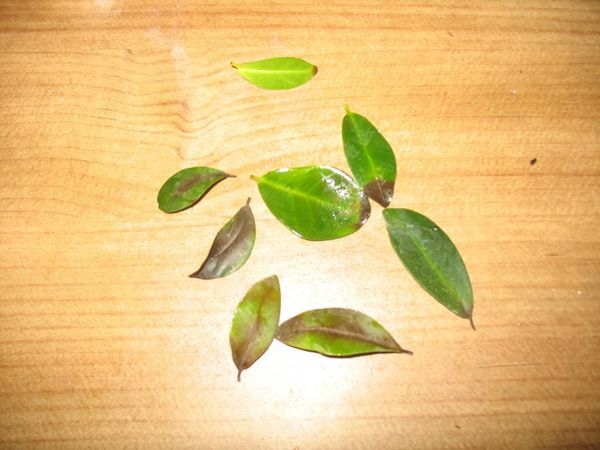

To prevent the ficus from drying out, remove it from direct sunlight, but it should not stand in the shade either. He will be fine on the windowsill on the east side. Lack of lighting will lead to the formation of weak shoots, twisted leaves, which the plant will soon shed. This is especially important in winter, when it is natural to lose leaves, and then you can skip the problem.
If you notice plaque or spots along the edges of the leaves, treat the plant from parasites. Do not forget that pests can also settle in the ground. The spider mite is a terrible enemy of the ficus.If you skip it, it will be very difficult to save the flower, because the tick will very quickly hit all the foliage.
Do not despair, even if the whole tree is completely dry. The tree can almost always be reanimated. But you shouldn't wait for that. Examine your flower. Leaves turn yellow at the edge, reduce watering. If the leaves dry up, then you need to reduce the light. The soil can also dry out - also from an excess of light or too dry air. This is the answer to the question of why leaves dry.
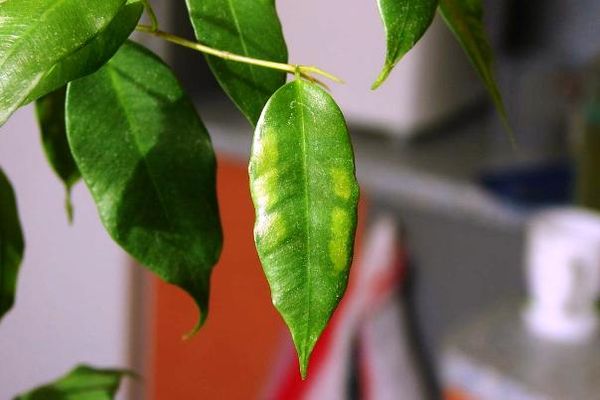

Remember that ficuses shed their leaves due to a lack of trace elements in the soil. Make sure there is enough in the soil. Do not move the flower pot from a warm room to a cold one. Healthy leaves also fall from such a sharp temperature drop. Watch out for the leaves, because healthy ones crumble only due to a change in temperature, and in other cases, affected leaves can fly around.
If the ficus begins to actively get rid of foliage, check everything: crown, stem, soil and roots, if the problem is not found on the surface.
The flower begins to dry, which means that critical mistakes were made during cultivation. Dried leaves cannot be helped anymore, so remove them immediately.
How to recognize nutritional deficiencies?
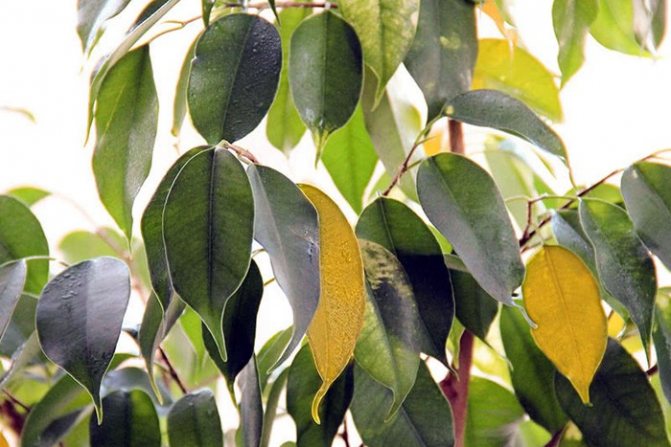

Curling at the edges and tips of the leaves indicates a potassium deficiency. A balanced multicomponent fertilizer should contain potassium, phosphorus and calcium in a ratio of 1: 2: 3.
If the plant is deficient in nutrients, do not increase the fertilizer dose, the ficus must first regain its strength. During the growth period, you should use top dressing once a week and change the fertilizer from time to time.
Natural process or disease?
In most cases, the main reason for the yellowing of the leaves is hidden in the natural factor. Adult plants change their cover from time to time, so if you have no doubt that the care of the ficus was correct, try first to determine how old it is in order to understand whether this factor is the reason for the change in the color of the leaf plates or not.
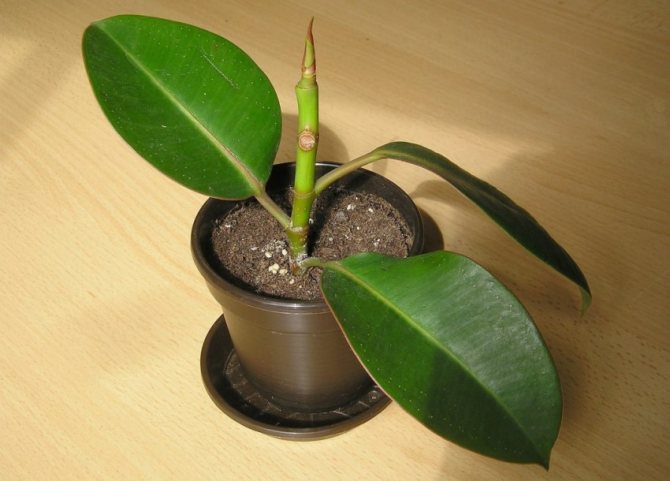

Why do ficus leaves turn yellow?


If ficus leaves suddenly turn yellow, there may be various reasons. Usually a virus or iron deficiency. In both cases, the responsibility lies with the excessive moisture to which the plant is sensitive.
When a virus attacks a plant, the first yellow spots appear on the leaves. As the disease progresses, whole leaves turn yellow. The viral illness usually occurs during cold and humid summers or as a result of stress caused by over-watering. It is necessary to reduce the amount of water supplied and avoid stagnation.
Loss of leaves is not a reason to throw out the plant, you need to study the rules of care. Ficus does not feel well in the company of smokers. If the plant is in a room where cigarettes are smoked, it may be the first cause of leaf shedding.
A common cause of yellowing is a lack of fertilizer, especially iron, which can be the result of stagnant water or too small a pot. Plant the plant in fresh soil, and reduce the amount of water. The water should not stand in the pot.
The main reasons for shedding leaves
If the leaves of the ficus do not fall off during the cold season, then it is necessary to find out the cause and eliminate it before the flower dries up. The reasons may be as follows:
- too dry air;
- the plant is in a draft;
- frequent changes in air temperature;
- flower transplant;
- moving to another room;
- too wet soil (due to frequent watering);
- the presence of parasites;
- fungal diseases;
- poisoning with pesticides.
If the cause is disease, how to determine what exactly the flower is sick with? Other reasons are easier to eliminate, since they are simply related to the living conditions of the plant, and if they are changed, the leaves will stop falling off.
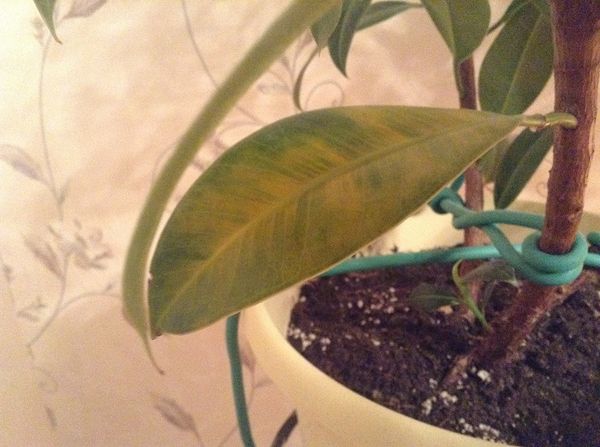

Most often, ficuses get sick from improper care. If you notice yellowing on the leaves, then the room is too hot. Perhaps this is due to the fact that you are constantly moving a flower pot from one room to another. Leaves fall off due to lack of nutrients. In addition, because of this, the leaves will also begin to shrink.
Have you noticed yellow spots on the ficus? It looks like you are filling it too much. Due to an excess of moisture, not only the leaves turn yellow, but the roots can also begin to rot. You can save a flower only if you understand the reason in time and, for example, adjust watering.
Overdo it with fertilizer, foliage will begin to crumble in a chaotic manner. Conversely, a lack of fertilization leads to the fact that the leaves die from the bottom up.
Another reason why leaves fall off a tree is pests. How do you find them? Brown spots and white bloom appear on the leaves. Getting rid of parasites is, in principle, easy. But with a fungal infection on ficuses, it is much more difficult to cope. Fungal diseases include gray rot, sooty fungus, etc. If you notice black, red bloom, mold on the outside of the leaf or on the stem, start treatment immediately. If the ficus is left unattended in this state, then it can throw off all the leaves.
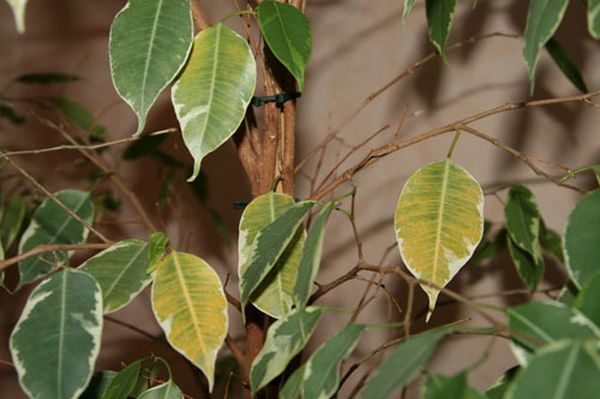

In general, ficuses are capricious plants. Growing them is a painstaking process. On the example of the rubber plant, we see that it can shed its leaves due to the fact that the pot is too small. The ficus turns yellow and sheds its leaves, because it is uncomfortable in cramped conditions, this flower loves freedom. Rubber plants need sunlight. They will react with yellowing to waterlogged soil.
Rubbery ficus can also turn yellow if it grows in unbalanced soil. As we can see, the cultivation of this green pet must be approached responsibly. It's time to find out what to do when the flower sheds its leaves at the wrong time and too abundantly.
Why do ficus leaves turn brown?
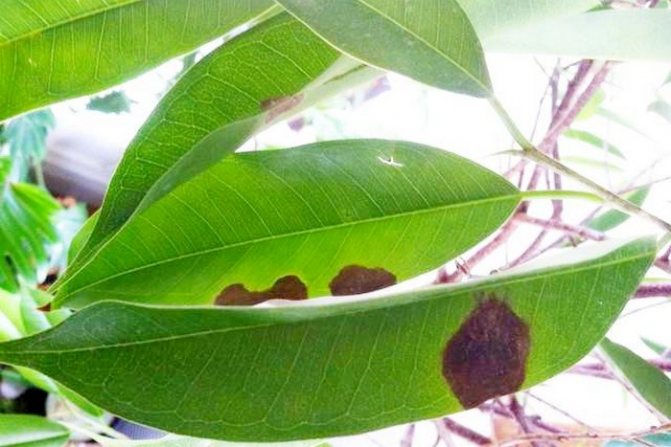

Discoloration can be caused by unfavorable conditions, fungal diseases or poor watering. Ficus nervously reacts to excess moisture. When the roots start to rot, the plant is unable to absorb water, and as a result, the leaves turn brown and fall off.
Brown leaves can be the result of excessive sun exposure or a lack of potassium and magnesium. Incorrect application of a fungicide or insecticide can cause browning and dropping.
Fungal diseases
Rust (Pucciniales) appear as small reddish-brown spots on the leaves of a ficus plant. The fungal mycelium deprives the plant of nutrients. The leaf dies and falls off.
It is necessary to react at the first signs of rust and remove the affected leaves. Fallen leaves must be carefully collected. Do not use for compost, fungus can survive. Ficus should be sprayed with an appropriate fungicide.
Viral disease
Many fig trees carry the mosaic virus. Before, young green leaves turn yellow, show a distortion of the leaf blade, as a result, fall off. Stress caused by humid environmental conditions and over-watering is responsible for the development of the virus.
In the pot in which the fig plant is grown, a drainage layer should be installed to prevent water stagnation. Once the plant is in the right conditions, it will create new, healthy leaves.
Diseases
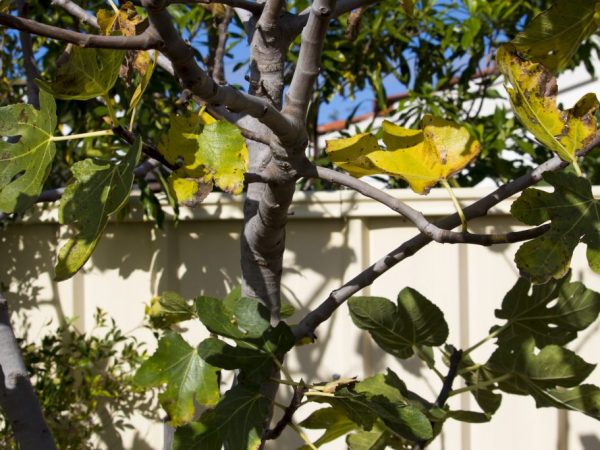

Improper care can cause illness
In the list of common reasons why ficuses shed their leaves, the first number is the emerging infections and care problems. In most cases, they are easily removable. Timely measures taken allow you to reanimate the indoor flower.
Avitaminosis
Lack of nutrients in the soil where the ficus grows leads to crushing of the leaves.With inadequate feeding and improper care, when a too dry climate and excessively high temperature indicators are created in the room, the situation is aggravated: the ficus leaves become smaller, you can see how they wilted and dry, which often leads to abscission. With insufficient fertilization, the ficus usually begins to fall from the bottom up.
Rot
When yellow spots appear on the leaves of the ficus, we can talk about rot on the root system of the plant, which manifested itself due to excessive watering. An excess of liquid, which does not have time to evaporate from the soil layer in the pot, leads to decay, yellowing, foliage and death.
Hypervitaminosis
Over-saturation of the soil with fertilizers also adversely affects the quality of the ficus foliage. For such reasons, brown spots appear on the leaves - specks, the foliage turns black and flies over time. The fall occurs randomly.
Pests
The presence of a spider mite, aphids, scale insects and other insect pests on the plant looks like convex spots of a brown or brown hue, the leaf blades turn white from plaque.
Parasites can settle along the veins of the leaf blade. You can save a flower from excessive shedding of leaves by using modern pest control products. As a result, a plant with a beautiful green crown will grow.
Fungal infections
Signs of rot and sooty fungus are black or red spots of mold, which are located on the outer part of the leaf blade and may be present on the stem of the plant. Ficus leaves affected by a fungal infection begin to turn yellow and fall off. A fungal disease not detected in a timely manner becomes a frequent cause of plant death, and in a short time.
Improper watering
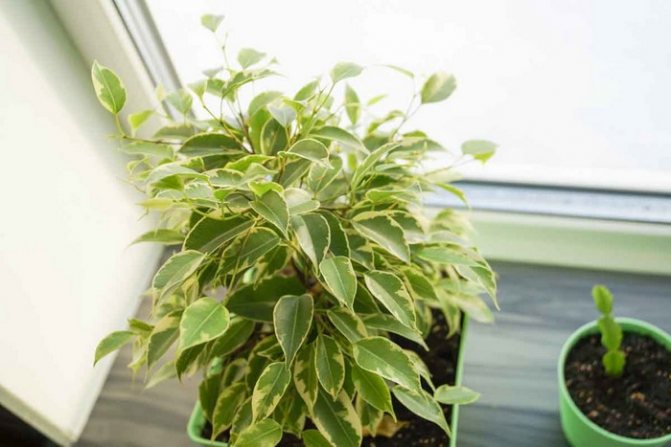

High temperatures and lack of water damage thermophilic ficuses. Plants cannot deliver enough moisture to the leaves, they begin to dry out from the edge to the inside, eventually falling off.
During the summer season, fig trees need to be watered regularly. House-grown specimens need water whenever the soil begins to dry out. The root ball should not be allowed to dry completely. When the substrate becomes excessively dry, the plant tries to protect itself from overdrying by reducing the transpiration area by shedding some of the leaves.
Where to put the ficus?
You need to find a place in the room suitable for the flower in advance. Moving badly affects the well-being of the ficus. Therefore, it is undesirable to rearrange it. Moving from a store to a permanent place of residence is a great stress for a plant. Often in such a situation, Benjamin's ficus sheds its leaves. It is better to buy it in the warm season, so as not to get cold on the way.
Lighting for ficus should be fairly bright, but diffuse and even. In winter, if the plant is located far from the window, the bush may take an irregular shape. The temperature in the room must be at least 15 ° C. It is necessary to ventilate the room, but avoid drafts.
Pruning and replanting
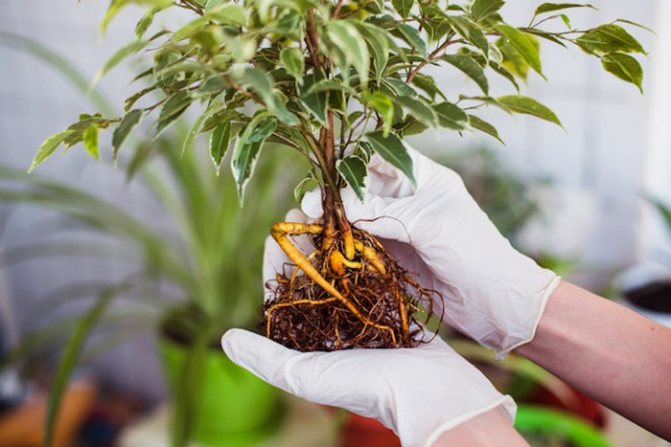

It is advisable to cut off the tips of the ficus twigs every spring. For two reasons. Thanks to pruning, the crown of the tree thickens, branches multiply. Secondly, the best shape of the tree can be formed by properly cutting the branches.
Ficus should be transplanted every 2 years into a pot with a diameter of about 4 cm. Transplanting will give your roots more space and nutrients, as well as a more stable base for the plant. In the case of large specimens, replacing a large pot can be problematic; you can limit yourself to replacing the top layer of soil (2-4 cm).
Why do ficus leaves fall: reasons and what to do
Ficus throws off leaves for two reasons. This can be either a natural process or a consequence of improper plant maintenance.That is why, before deciding how to save the ficus, you need to determine the exact reason for this condition.
Did you know? The largest ficus banyan tree grows in India. Its age is more than 200 years, the diameter of the main trunk is 12 m. The crown of this tree has grown to 12,000 m² and is supported by secondary and aerial roots that have grown to the size of individual trunks.
Natural process
The normal life rhythm of a ficus plant includes the stage of shedding foliage. This is a natural process that occurs in the fall or early winter. Due to the loss of leaves, the plant successfully goes into a dormant state.
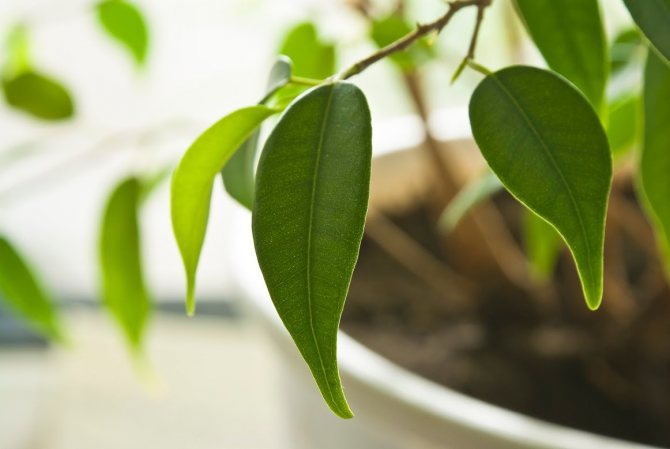

In the future, the leaf plates must necessarily grow back. Most often, the ficus first loses the lower parts of the crown. First, they acquire a yellowish color, then they begin to dry and fall off.
Improper care
Very often, the reason for the loss of foliage by ficus is the wrong approach to its content. Microclimate disturbances, improper watering and transplanting negatively affect the state of the plant, from which leaves begin to fall off.
Containment breach
The microclimate when growing ficus plays a very important role. Cold and drafts are extremely harmful to the plant. In most species, if the temperature drops below + 16 ° C, foliage is likely to fall off.
Important! It is highly advisable to avoid sudden changes in temperature, humidity or lighting levels. The plant does not like changes, including a change of location.
You should also avoid exposure to high temperatures. Although the ficus is classified as a thermophilic species, at rates above + 30 ° C, the plant withers, the leaf plates change color to yellowish and are hardly kept on the stem. However, it is necessary to pay attention to the specific cultivated species and the optimal performance for it.
An important factor is the level of moisture in the air. Leaves often crumble due to excessive dryness. This often happens in the summer, when it is hot enough outside and the air in the room also warms up above normal.
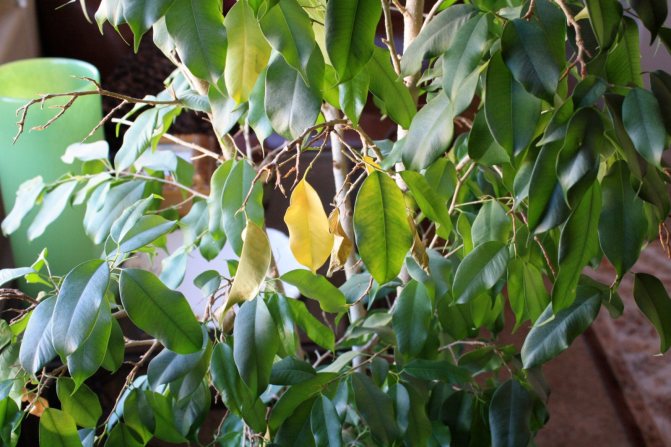

However, even in winter there is a risk of increased dry air due to the operation of batteries or heaters. The owner needs to monitor the humidity and, if necessary, adjust its indicators using special air humidifiers.
We must not forget about lighting. Species characterized by a variegated pattern on leaf plates are difficult to tolerate light shading. Varieties with green leaves are capable of developing in partial shade conditions.
Also learn what to do if Benjamin's ficus drops leaves.
However, too strong a shadow adversely affects the state of any ficus. As a result of being placed in a dark space, symptoms may occur in the form of a weakening of the crown, lethargy, foliage dryness and, as a result, its falling off.
Improper watering
Watering the ficus should be moderate. Strong drying of the soil should not be allowed. A similar situation can happen due to poor or rare soil moisture. As a result, the crown dries, turns yellow and does not stay on the trunk for a long time.
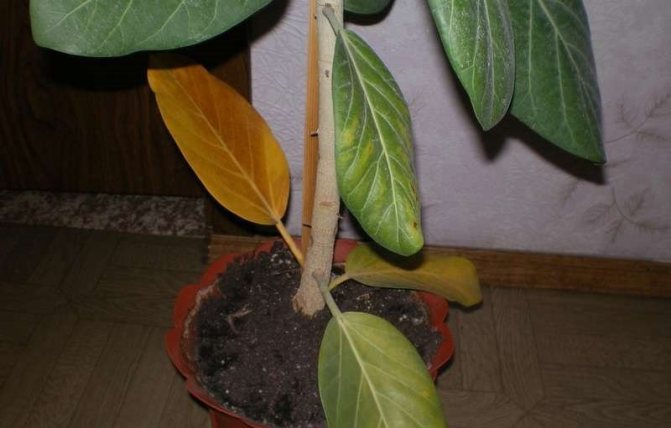

A similar effect occurs if the watering, on the contrary, is too abundant. Water stagnation in the soil should not be allowed, since the process of root rotting begins. It can be identified by an unpleasant putrid smell. If the situation is not corrected in time by adjusting the watering, a gradual damage to the trunk begins. At the same time, the leaves acquire a dark color and fall off the stem.
Read more about the features of watering ficus at home.
Incorrect transplant
Since ficuses do not tolerate any changes, a reaction in the form of dropping foliage may appear during transplantation. It is for this reason that the plant cannot be repotted frequently.
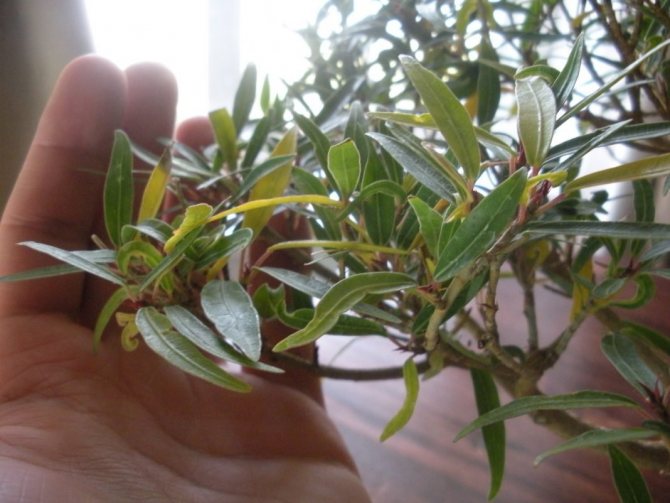

The maximum frequency of changing the pot and soil is 2 times a year. Often, flower growers, knowing about the possible reaction of the plant, resort only to a superficial change of soil instead of a full-fledged transplant.
Pesticides
In pest control, pesticides are the first aid for many home plant owners. Chemicals are also used to prevent the development of various diseases.
The effect of intensive processing of ficus with such preparations is often negative. Pesticides are dangerous because they create a strong load on the plant, as a result of which the leaves do not linger on the trunk, weaken and fly around.
Important! When processing pesticides and other drugs, you should adhere to safety rules. It is advisable to use rubber gloves and goggle eye protection.
Pests and diseases
The development of various diseases becomes a common cause of leaf fall. Fungal lesions are dangerous for ficus. They appear most often due to excessive moisture in the substrate.
In addition to shedding the crown, the fungus causes discoloration and spotting on various parts of the plant. As a therapeutic measure, you need to get rid of the affected areas and treat with a fungicide, for example, the drug "Carbendazim".
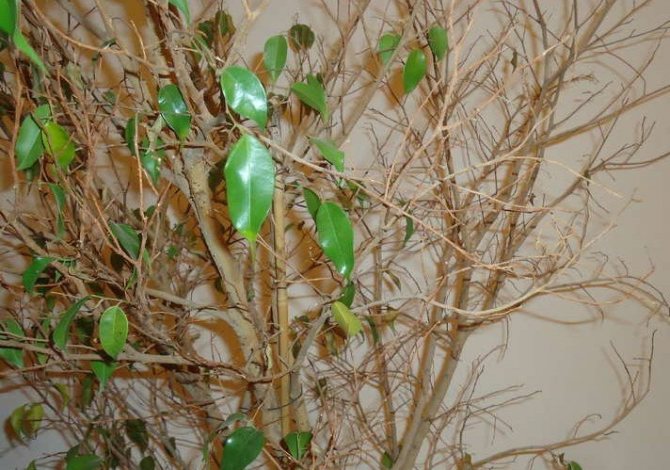

Pests are no less dangerous, among which you can most often find:
- aphids;
- spider mite;
- scabbard.
Insects suck out juices from the leaf plates, as a result of which they become weak and do not stick to the trunk. The first help in this case will be manual collection and destruction of pests with a soap solution. Next, the plant should be treated with a systemic insecticide, for example, Actellik or Inta-vir.
We also recommend that you find out what to do if the leaves of the ficus turn yellow and curl.
Fertilizer
During the growing season, fertilizing with liquid fertilizers every 2-3 weeks. Fertilization is not necessary if the plant is regularly replanted.
There are at least a thousand different types of ficuses in the world, but Benjamin's ficus is most often used as a houseplant. Due to its excellent decorative qualities and unpretentiousness, this flower has a huge number of hybrids, differing in size, color, crown shape and many other features.
But there are problems that all Benjamins are almost equally susceptible to. In particular, we are talking about such an unpleasant phenomenon as shedding foliage. There may be several reasons for such a misfortune, but, as a rule, all of them can be described in one phrase - improper care.
The subtleties of preserving the crown of ficus
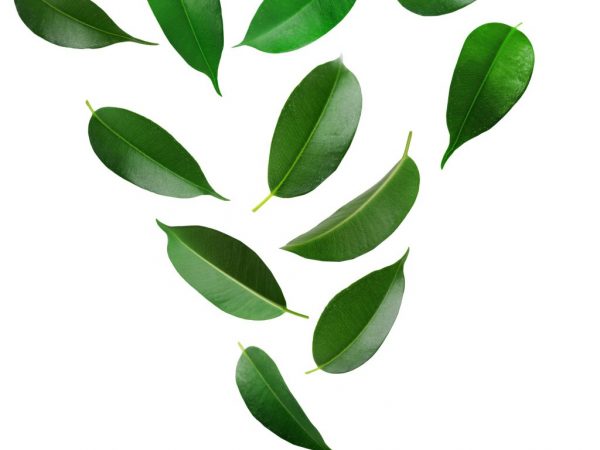

Different varieties have their own characteristics of care
In the course of growing various types of ficus, many growers have noted for themselves that this plant reacts unfavorably to some factors.
sunlight
Not all species like direct sunlight on the leaves. If the variegated types of flowers are light-loving, some ficuses, for example, Benjamina, prefers shading for comfortable well-being.
In winter, it is recommended to place the flower pot closer to the window, because the lack of lighting in the place where the ficus grows will certainly affect the quality of its leaves - they will begin to fall off.
Water
Ampel large-leaved varieties of ficuses love frequent spraying. To preserve their foliage, sufficient moisture is most important, therefore, during the growing process, many growers install a flower pot directly on pallets with pebbles or expanded clay and constantly keep them moist.
Unlike ampelous species, tree-like ficuses like their soil layer to be dried and there are no lumps.
Transfer
Frequent replanting adversely affects the quality of the foliage of all types of ficus. Often, for this reason, indoor flowers begin to shed their leaves, because experienced growers are of the opinion that the plant should be transplanted no more than once every two years.
For already grown large plants, only the top layer of soil is subject to replacement.
Change of location
Ficus belongs to the category of indoor plants that tolerate a transplant more easily than a seemingly harmless change of habitat. Even turning the pot around its axis and thus changing the angle of illumination can cause “indignant” leaf shedding.
Therefore, a novice florist needs to remember one very important rule: having acquired a ficus in a store and bringing it into the house, it is imperative to immediately transplant the plant into a new pot, and then put it in a predetermined place, naturally, selected taking into account the requirements of the ficus to the temperature mode and lighting.
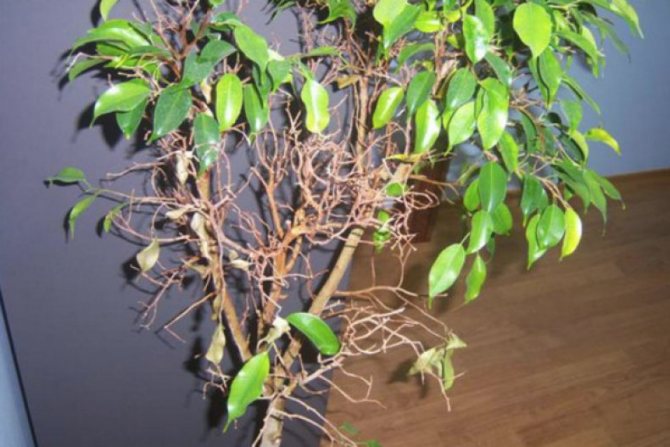

If Benjamin is not transplanted right away, it can start shedding foliage due to lack of nutrients in the soil. This is another possible cause of the problem.
It is necessary to free the ficus from the ground carefully, trying, if possible, not to disturb or expose the root system, all the more important not to damage it. So the flower will more easily endure the shock and quickly settle down in a new place.
Do not be upset if the newly purchased Benjamin dropped a few leaves, for the adaptation period this is normal. Experts recommend buying these flowers in the warm season, in this case, the loss of leaves as a result of moving will be less.
Advice
In the event of a sudden shedding of the foliage of a ficus tree, when the causes are not natural, it is necessary to check all possible options and highlight the one that is most likely to be the cause of damage to the plant.
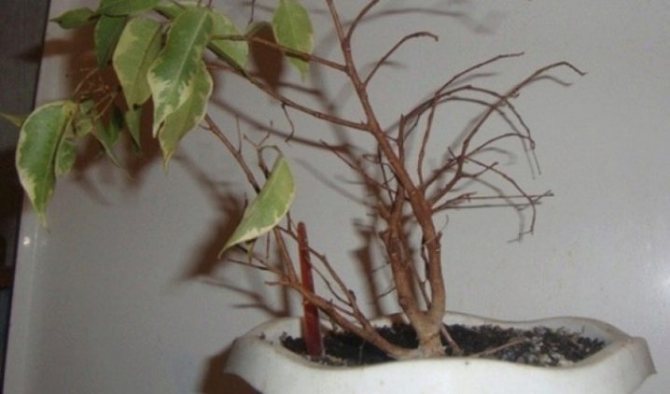

There are some tips to help prevent foliage from shedding.
- It is worth paying attention to the soil, how much it is watered and whether it is overdried. In case of waterlogging of the soil, watering should be completely stopped for two weeks in order to completely dry the soil and roots. If this measure does not lead to the restoration of plant health, you should try to transplant it into new soil and water it a little.
- One of the reasons for the loss of the crown may be a lack of nutrients, and if so, then you just need to add a solution containing phosphorus, nitrogen, potassium. You can use organic matter in the form of chicken manure, mullein and humus, and from improvised means can help: coffee grounds, sugar, waste from fruits and vegetables, yeast, nettle infusion, ash and tea leaves. Among the most popular drugs are "Rainbow", "Agricola" and "Pocon".
- Examine the bush for pests. It is important to pay attention to the soil in which the ficus grows, to check for harmful microorganisms in it, and also to examine the branches and crown. If insects are found, they must be dealt with immediately with the help of insecticides. The scabbard must be fought with soapy water, which is used to wipe all the leaves. If this does not help, you can use the drug "Actellik". It is better to cut off the affected areas that could not be saved. Spider mites can be fought by washing with plain warm water and increasing the humidity in the room. At a serious stage, Actellik will help out.
- The reason for the falling leaves may be hidden in the root system, so it must be carefully examined. The ficus is removed from the pot, all the soil is removed and the roots are carefully examined for rot. If damaged areas are found, they are removed, and the cut site is lubricated with crushed coal, followed by transplantation into a new pot.
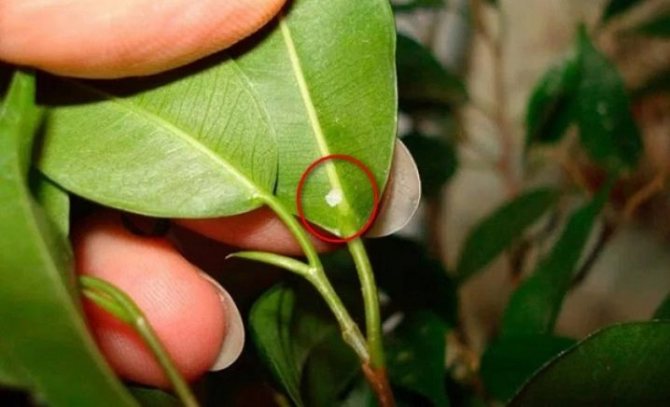

The causes of foliage falling can be of a different nature, but their timely identification makes it possible to save the plant before any serious changes begin.
For information on how to properly transplant ficus, see the video below.
«>
Lack or overabundance of lighting
Ficus Benjamin is an evergreen tree native to the tropics, or more precisely, the upper tier of tropical forests. It is not surprising that such a plant is very sensitive to lighting conditions.
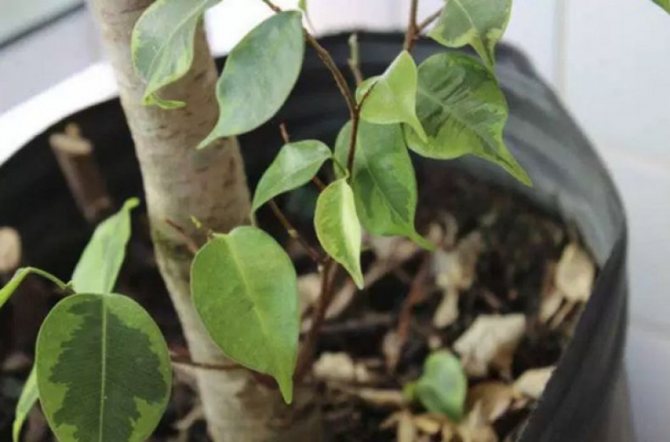

For the pot, you must definitely choose a bright place, but the flower must be protected from direct sunlight. Photophilous ficus will surely respond by dropping foliage to a lack of light, however, the scorching sun can cause the same reaction.
Despite the fact that tropical plants, unlike the inhabitants of the temperate climate zone, are focused on short daylight hours, in winter it is still useful for ficus to organize additional lighting.
The best option for Benjamin is a 60 cm long lamp with a power of 18-20 W, located above the plant at a height of about 30 cm.On cloudy days, it is recommended to keep such a lamp turned on around the clock, then the plant will not experience a lack of lighting.
How to save ficus from yellowing
The above were considered the most common reasons, on which the leaves of the ficus can turn yellow and fall
... It is much easier to prevent the development of the disease than to treat it later, therefore it is recommended to monitor the conditions of the plant. When certain symptoms occur, it is important to determine the type of disease in order to take decisive measures to get rid of and preserve the plant.
Ficuses with light or variegated colors need to be provided with sufficient lighting, but with a shielding of direct sunlight.
For harmonious growth, timely application of fertilizing and micronutrients is required, especially during the period from March to October. It is not worth feeding the plant during the dormant period.
Temperature violation
Benjamins can feel comfortable in a fairly wide temperature range. During intensive growth, most of these plants prefer warm air ranging from +25 to +28 ° C, and during the dormant period they easily tolerate a decrease in temperature to +15 ° C.
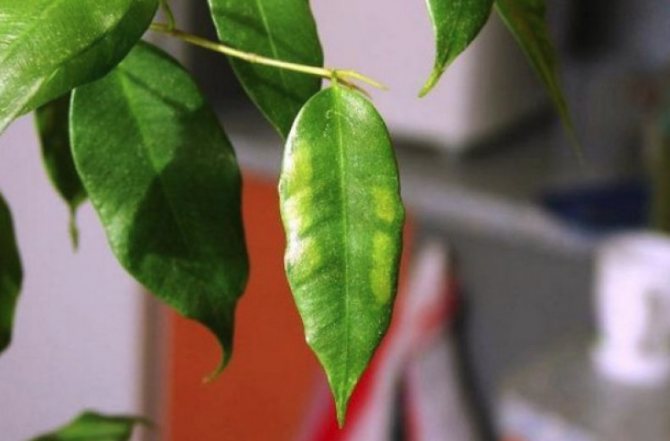

However, the plant with a high degree of probability can react with fallen leaves to the deviation of the thermometer above or below the specified threshold indicators.
In particular, the cause of leaf fall can be:
- draft;
- finding a pot with a flower in the immediate vicinity of a heat source, when hot air enters from one side or another pointwise;
- the flow of cold air entering the plant, for example, as a result of opening a window or a vent for ventilation;
- difference between night and day temperatures.
When choosing a place for a houseplant, you need to think over everything in advance in such a way as to exclude any of the above stresses.
So, for example, if you place a ficus plant on the windowsill next to a hot radiator and open the window sash to slightly lower the temperature in the room, no tricks will save the flower from intensive dropping of leaves.
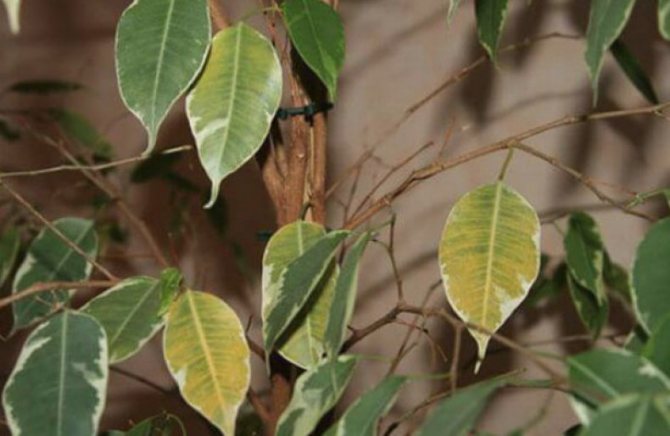

Care
Ficus can be prevented from dropping leaves as follows:
- Regularly check the moisture content of the substrate (soil). If it is too moist, stop watering. Check the roots in two weeks. If they are dry, we resume watering. If after these actions the flower does not recover, we transplant it into a new soil, which we pre-disinfect.
- It is possible that the plant has not been fed for a long time, and it does not have enough fertilizers. We introduce microelements according to the instructions. As a top dressing, you can use wood ash. It is rich in phosphorus and potassium and will serve as an additional source of nutrients.
- We carefully check the tree for the presence of fungi, insects and pests. We examine the soil, stem and leaf plates. In the presence of pests, we immediately take the necessary measures to remove them.
- We carefully examine the roots. We carefully remove the root from the soil and conduct an inspection. If the root system is rotting, cut off the dead roots, sprinkle with crushed coal and plant in new soil. You can pre-treat with a solution of potassium permanganate.
- We prepare the soil from ripe foliage, peat and river sand in a ratio of 2: 2: 1, having previously calcined for safety.We put expanded clay or gravel at the bottom for drainage. Additionally, you can add charcoal.
- When transplanting young trees, choose a pot 2-4 cm wider, leave the roots with the ground so as not to injure the plant. In adult plants, we change only the top layer of the earth.
- We select a well-lit place and try not to move the pot from place to place. We avoid drafts and low temperatures.
If the plant has lost all its foliage, do not despair. Even a completely bare tree can recover and grow green shoots. Having made some efforts to save it, you can restore health to the ficus. You can check its viability as follows. If the twigs have not lost their flexibility, and when cut with a knife, milky sap is released, the tree has not dried up, and you can help it.
Subject to all the above recommendations, the flower will delight you all year round with a beautiful dense crown. You cannot be upset if the tree is sick and begins to shed its foliage. It is necessary to find out why the leaves of the ficus are falling, and to take all measures that will help return it to a healthy appearance. The main thing is to find the problem in time.
Watering errors
Like most indoor plants, the ficus does not like stagnant potted water.
When transplanting, it is imperative to ensure that there is a sufficient drainage layer and watering only as the top layer of the soil dries up.
But a lack of moisture can also cause foliage to fall off, because in this case it is impossible to assimilate nutrients from the soil, in addition, the movement of cell sap is limited and the process of photosynthesis slows down.
It is also important for Benjamin that the amount of moisture that he receives changes correctly according to the changes of the season. In autumn and winter, watering should be reduced; in spring and summer, the flower needs more water.
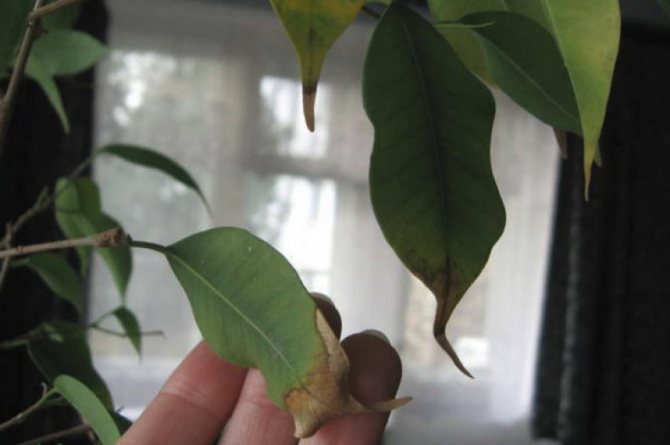

So that the soil in the pot does not dry out, it is recommended to periodically carry out the so-called "dry watering" - gently loosen the soil surface with a toothpick or fork, trying not to damage the root system.
One of the possible causes of Benjamin's leaves falling off is the use of cold water for irrigation. All tropical plants need to be watered with lukewarm and always well-separated water.
Wrong flower transplant process
According to most gardeners, the plant needs to be replanted once every two years. It is this period that is considered the most optimal, since in two years the roots of the plant have time to completely braid the soil in the pot.
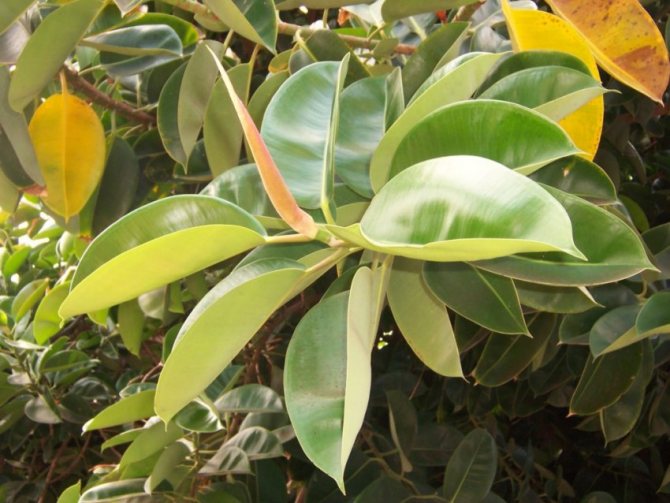

The transplant should be performed according to the following rules:
- First, the plant, after being pulled out of the container, must be shaken off all excess soil.
- Secondly, a flowerpot of a sufficiently large size must be prepared for the flower.
- Thirdly, the pot should be covered not only with a drainage layer, but also with a good quality earthen mixture.
Lack of fertilizer
Feeding a houseplant is an important element in caring for it, because the amount of soil and, accordingly, the nutrients in it available for the root system is very limited.
Not receiving the necessary components for normal development, the ficus begins to ache and shed its foliage.
Fertilizers should be applied during the period of intensive growth (spring and summer), using universal organic and mineral mixtures. It is best to purchase special fertilizers for ficuses or, if none were found, combined additives for non-flowering indoor plants.
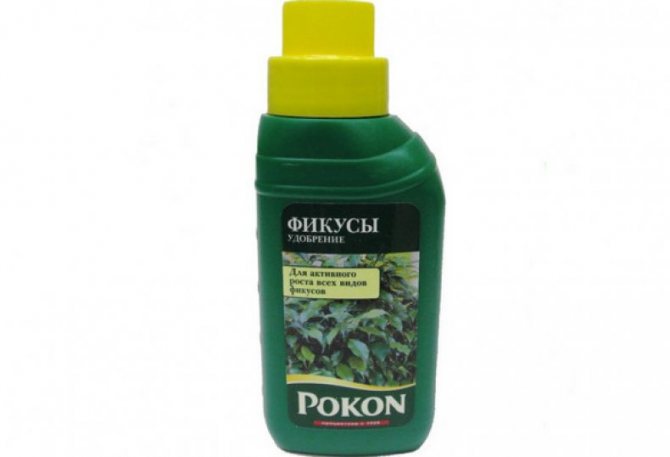

The usual frequency of feeding is twice a month, however, depending on how long ago the plant was transplanted (the degree of soil depletion), this frequency can be adjusted. Do not apply fertilizer immediately after transplanting, as this can lead to root burns.
In the wild, tropical plants practically do not have a dormant phase; their vegetation lasts all year round.Once in the temperate climate zone as indoor flowers, the ficuses began to adapt to new conditions, which is why it is better not to disturb them in winter.
But if the temperature regime is selected correctly and the tree is provided with round-the-clock illumination, it does not need rest, which means that it can be fed in winter, using half of the usual dose of fertilizers and halving the frequency of their application.
Also, during this period, the nitrogen content in the top dressing should be slightly reduced, because this element is needed for intensive growth and a set of green mass, which still does not happen in winter.
Symptoms and Treatment
There are many symptoms of plant diseases: blackening or yellowing of the leaves, as well as their wilting, twisting and falling off, slowing down of flower growth, nodularity or decay of roots, the appearance of plaque or spots on the leaves. Let's take a closer look at Ficus disease with a photo.
Blackening
Why do Ficus leaves turn black at the edges? Most likely, the reason is improper care of the plant.
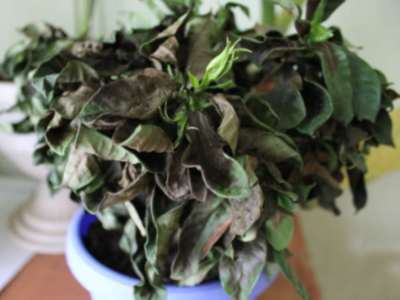

- The problem is in the wrong solar or thermal mode.
What to do? You should pay attention to the location of the flower: it should not be in direct sunlight and in a hot dry room. - If a the leaves suddenly turned black and fell, the problem lies in improper watering. Most likely, the soil is waterlogged, that is, you water the flower too often or too abundantly. Despite the fact that the flower loves moisture, over-watering will only harm it.
- If they constantly turn black, despite proper care, then the problem is most likely in the composition of the soil that is not suitable for the flower.
- If sometimes darken but they constantly wither, the problem is an excess of fertilizers. It is not worth feeding a recently transplanted plant: the new soil contains enough substances necessary for growth.
It is also undesirable to fertilize Ficus in winter, since an excess of minerals in the ground with a lack of sunlight and heat leads to a weakening of the plant (read more about caring for ficus in winter here).
IMPORTANT! It is better to put the flower on the north window so that it receives enough light, but at the same time the sun's rays do not injure the flower.
ATTENTION! It is recommended to water the plant twice a week and little by little, and you can prevent drying out by spraying the foliage with water from a spray bottle every day.
REFERENCE! The soil for the ficus should be slightly acidic or neutral, most often the so-called "leafy earth" (sold ready-made in flower shops) is mixed in a pot with peat and humus in a ratio of 2: 1: 1, it is possible to add a small amount of sand. The diseased plant must be transplanted into a suitable soil substrate.
IMPORTANT! Excess fertilization leads to soil salinity, which is bad for the condition of the plant. Ficus should be fed every two months with a weak solution of special fertilizer.
Yellowing
Yellow leaves are a common nuisance that Ficus owners face.
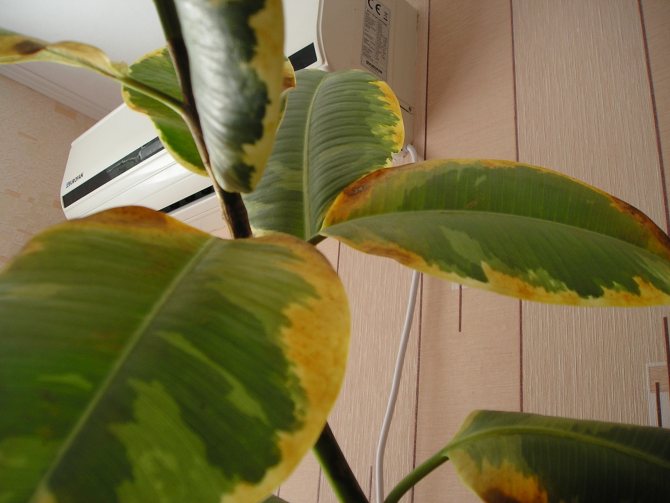

- If the yellowing is caused by a natural wilting process, then there is nothing to worry about: like all plants, the flower sheds old leaves. Falling of the lower leaves of a flower in autumn and winter is a common occurrence. As a rule, the lifespan of a leaf is no more than two years.
- If Ficus massively sheds leaves after you move the pot to a new location, then the plant is under stress.
- A possible cause could be dry indoor air.
What to do? If the flower is on the window, you need to close the battery in the cold season and spray the leaves regularly. - If this happens after the flower has been poured, it is necessary to stop watering for a couple of weeks so that the roots of the plant do not rot.If this does happen, the ficus should be transplanted into new soil and the decayed roots should be cut off.
- Ficus are very sensitive to air vibrations. Pay attention to where the flower is. If he is constantly in a draft or under an air conditioner, then most likely his leaves will turn yellow and fall off.
- Yellowing can be caused by a lack of nutrients in the soil. In this case, helping the flower is very simple: you need to feed it with any fertilizer suitable for Ficus.
IMPORTANT! The plant is very sensitive to temperature changes, so it is not recommended to move it frequently from place to place.
What is the cause of the yellowing?
ATTENTION! Do not put the ficus pot next to a door, fan or air conditioner, or on a window if it is blowing.
REFERENCE! The main element necessary for a plant is nitrogen, in addition to it, phosphorus, potassium and calcium are included in mineral fertilizers.
White bloom
White dots on Ficus, what is it?
Dry white spots on the plant that are easily erased from the leaf are called powdery mildew and are fungal infections of flowers. White spots appear if the plant stands in a room with stagnant air or if fungal spores have got into the damaged leaves.
How to cure Ficus? You can treat the plant with a folk remedy - wiping with a solution of laundry soap or modern - spraying with a preparation containing copper salts.
If the white bloom on Ficus looks "fluffy", then the reason for their appearance is plant infection with mealybug. In this case, it is necessary to thoroughly process the flower, removing plaque and pests and then washing it with warm water, and then sprinkling it with a drug-actelik.
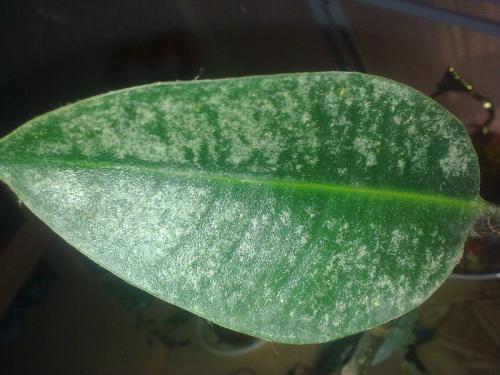

ATTENTION! Actellik's solution must be done in strict accordance with the instructions, and the drug itself, due to its toxicity, must be kept away from children and pets.
Brown spots
If Ficus has brown spots on the leaves, then the cause should be sought in excessive watering: most often such a lesion indicates root decay.
If brown spots appear on the leaves of the flower, it is necessary to transplant the plant as soon as possible, cutting off the decayed roots.
Large brown spots on the edges are a sign of an excess of minerals, in this case it is worth revising the fertilization regime of the plant: we remind you that you need to feed the flower only during the growing season (spring and summer) and with a frequency of once every two months.
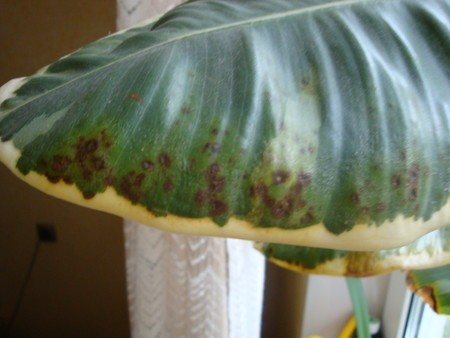

What to do if Ficus leaves fall?
There are several possible reasons why Ficus leaves fall:
- Improper watering. The optimal watering regime for the plant is twice a week.
- Plant stress due to rearrangement. What to do in this case? It is recommended to allocate a permanent place for the flower and rearrange it as rarely as possible. Also, sharp changes in temperature and humidity should not be allowed. The flower should not be placed in a draft.
- Low air humidity. To eliminate it, you need to regularly spray the plant with a spray bottle.
- Excess fertilizer. Do not overuse fertilizers, too frequent feeding leads to soil salinity and plant death.
- Why are Ficus leaves crumbling? Incorrectly selected soil composition. You should buy special land for ficuses or make your own soil mixture (the earth is mixed with sand, peat, humus, expanded clay is added to loosen it).
If Ficus threw leaves in autumn and winter - absolutely normal and natural phenomenon, you should only worry if they crumble during the growing season, that is, in spring and summer.
Let's take a closer look at what to do in the video below:
The effect of temperature on the plant
Ficus should neither be overdried in a hot room, nor overcooled. What to do if the flower still suffered from a temperature violation?
- If the plant is frozen, it is necessary to remove it from the draft (if it is on a ventilated window or under an air conditioner) and ensure a constant temperature of about 20 degrees.
The frozen flower should be sprayed with settled water at room temperature and not watered until new shoots appear. After the plant comes to life, you can water and fertilize it as usual. - If the plant stands in a hot room with insufficient air humidity, then the tips of the leaves dry out at Ficus, and they also begin to dry, curl and fly around, shoots may fall off.
If the flower is dry, water it with settled water at room temperature, move it away from the battery and spray it with water every day.
Has the flower slowed down or stopped growing?
The reason should be sought in improper care (incorrect solar and temperature conditions, excessive watering, lack of feeding). Eliminating the issue of leaving will bring your Ficus back to life. For prevention it is necessary transplant the plant every 1-2 years into a larger pot.
REFERENCE! Indoor plants can only be transplanted during the growing season, preferably in spring, so that the roots grow well in a new pot.
Diseases and pests
Poorly chosen conditions for keeping a flower, in particular, a violation of the lighting regime, humidity and temperature imbalance, can cause the development of various diseases and, as a result, all the same foliage.
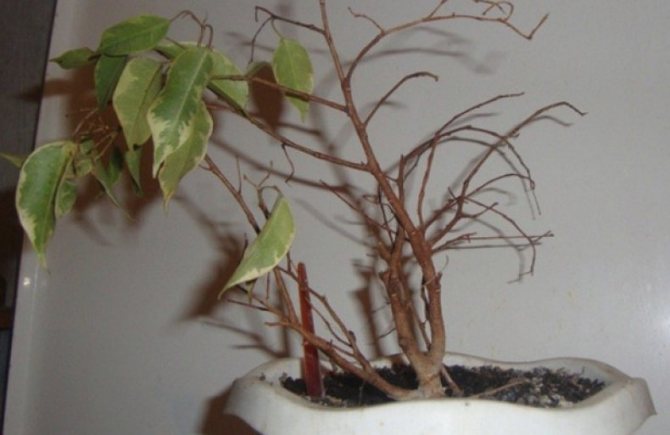

Most often, Benjamin suffers from attacks by spider mites, scale insects, aphids and mealybugs.
The attack of these pests is evidenced by the appearance on the leaves (especially from the reverse side) of discharge similar to powdery lumps, resinous spots, traces of cobwebs. The affected leaf turns yellow over time, dies off and falls off.
Having discovered a problem, the first step is to arrange a warm shower for the flower, thoroughly washing each leaf with soapy water (the earth in the pot must first be wrapped in polyethylene so that soap and excess water do not get into it).
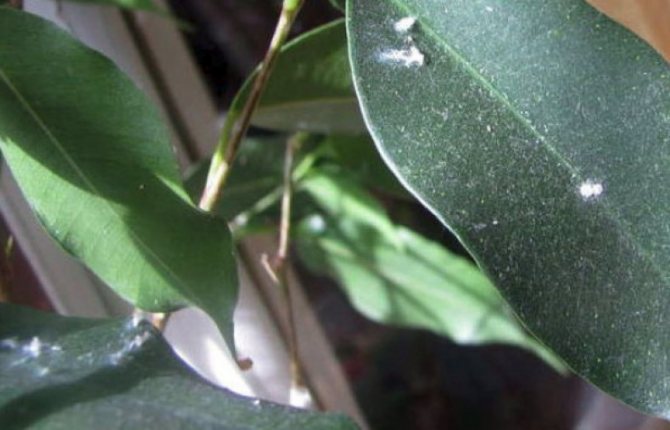

Spider mite on ficus If after a while the pest manifests itself again, you should proceed to radical actions in the form of treating the plant with a solution of a suitable insecticide.
Along with pests, Benjamin is also susceptible to some fungal infections, in particular, sooty and marsupial mushrooms are dangerous for him. (causative agent of powdery mildew). This kind of disease must be fought with fungicides.
In addition to the use of pesticides, it is imperative to analyze the causes of the problem, since, we repeat, under the right conditions of detention, Benjamin usually does not get sick.
One of the most unpleasant diseases that ficus owners have to deal with is root rot.... Its carrier is a specific fungus, which begins to multiply intensively in waterlogged soil.
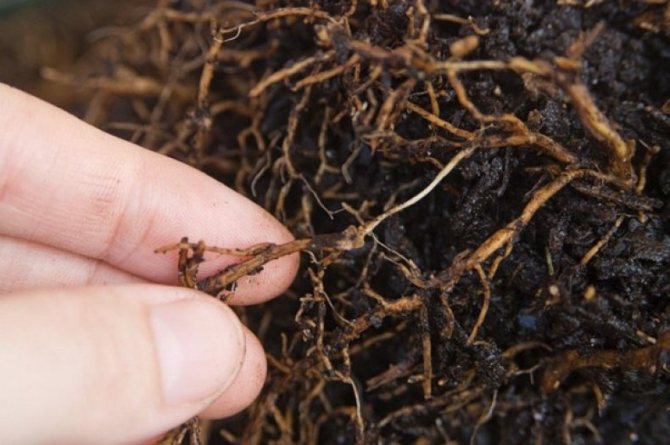

Root rot of ficus Unfortunately, this problem requires "prompt" intervention - an emergency transplant with a complete replacement of the earth and removal of rotten roots. Sometimes even such measures are insufficient, and the plant has to be thrown away with the pot.
It is worth noting that changing leaves for ficus is a natural process. The tree itself at home can grow for about fifteen years, but the average age of each leaf is three years.
Having outlived their age, the leaves turn yellow and fall off, therefore, when the plant drops a couple of leaves, there is no reason to panic. But natural aging never leads to massive leaf fall.
Reasons for falling foliage
If the ficus has thrown off the leaves or they have dropped, wilted, bent, curled up, turn yellow and brown, fly around not only when the cold season comes, the reasons lie in improper care: the home flower is missing something.
One of the most common reasons for leaf fall is a change in climatic conditions in which the plant is used to developing, which often occurs during its reproduction or transplantation.
Often, a change in the location of a flower pot is a temporary phenomenon, so that a flower with twisted leaf blades hangs down the foliage, and then throws it off. In such a situation, it is quite possible to restore the former beautiful crown of the flower, root it until the leaves of the ficus have completely fallen off.
Among other reasons why the ficus sheds leaves, the most famous in home floriculture are distinguished:
- excessive importance;
- sudden changes in temperature and drafts,
- moving to new conditions immediately after transplanting,
- insufficient lighting,
- oversaturation of the soil layer with moisture,
- the presence of insectivorous parasites and fungal infections,
- pesticide-shipped earth.
Wrong location
Ficus is best suited for a place near the east or west windows. They provide diffused light and protect the plant from direct sunlight.
The preservation of foliage directly depends on how well the pot was located, because the capricious Benjamin gives the owner only one attempt to place himself correctly - for each subsequent one you will pay with lost leaves.
In addition to temperature and lighting, it is also important to provide the plant with sufficient moisture, do not forget, our flower comes from the tropics, for which dry air is completely uncharacteristic.
In winter, when the air in the room is dry under the influence of centralized heating, the lack of moisture can especially adversely affect the state of the ficus.
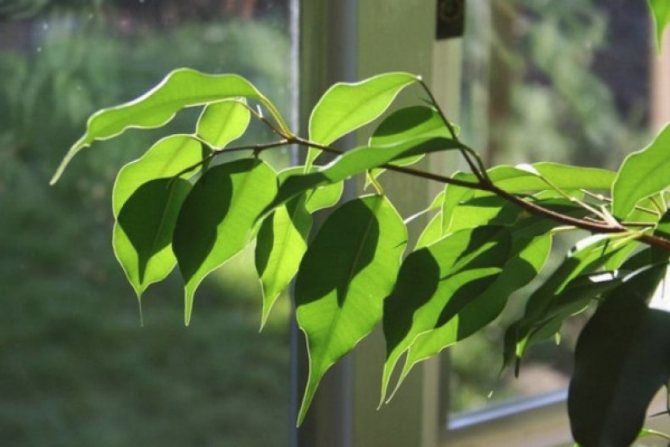

Therefore, during this period, Benjamin needs to ensure daily abundant spraying of the leaves. As with watering, the water should be slightly above room temperature.
If possible, the pot should be placed further from the heating radiator (the minimum distance is two meters), but if this is not possible, as, for example, in a city apartment where the battery is located directly under the window, in addition to spraying the leaves, you should also put dishes filled with liquid, or put a terry towel soaked in water and constantly make sure that the water does not evaporate completely.
Benjamin is a very beautiful houseplant, which also has a lot of useful properties. Caring for this type of ficus at home is not a big deal, but compliance with the basic requirements is mandatory. If an evergreen tree begins to shed its foliage, it means that you have made a mistake in something. Fortunately, in most cases, these errors are quite obvious and usually easy to fix.
The time is coming
For many lovers of ficuses, the period when the latter suddenly begins to shed its leaves becomes a complete surprise. They begin to look for the reasons leading to the fact that the leaves turn red, darken to the color of rust, their tips curl inward, bend and deteriorate.
So, for the flower Benjamin (Balzamin) and its curly variety Nitida, the slightest changes in the state of room comfort become the reason for the loss of leaves: a change in care methods, transplantation, an attempt to propagate in winter or autumn.
Ficus, even with full care, loses leaves annually, this is a natural process of changing foliage in winter. Subsidence occurs at the onset of the autumn-winter season. This is due to the aging of vegetation and the need for its renewal. Immediately with the arrival of cold weather, the leaves fall, become lethargic, turn yellow, curl and crumble. In winter, the leaves on the ficus plant fall off or dry out not entirely, but only the lower ones, falling at the beginning of the trunk. With the onset of spring warmth, new and young ones will grow on the empty trunk of the ficus.
How to help a ficus
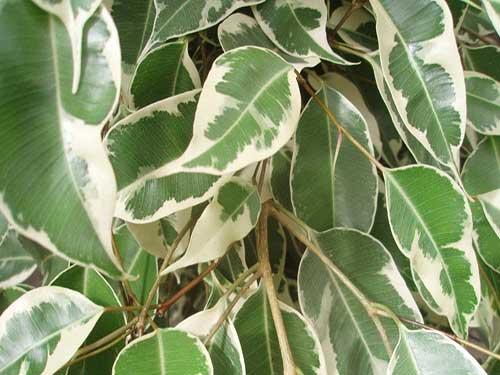

What to do if your pet suddenly begins to feel unwell and there is a need to come to his aid? Based on the symptoms and external conditions, determine what exactly led to the disease.Start caring for your pet, adhering to the rules of maintenance. Ficus Benjamin, like the rest of the variegated, does not tolerate exposure to direct sunlight, waterlogging of the soil, placement in a draft. He loves light, but needs shading in the middle of the day. In winter, it is required to create a high-quality lighting system - the pots are moved closer to the windows.
Since a lack of light can provoke the development of crooked and weak shoots, as well as leaf fall. If you create optimal conditions for the plant - adjust the temperature and humidity, make lighting, then leaf fall will stop. Periodically it is advised to shake the ficus, get rid of dry and falling leaves. So the plant is freed and gets oxygen access to dense foliage. Prevention of the appearance of pests is considered to be washing the surface of the leaves. To combat spider mites and thrips, special insecticidal preparations have been invented.
Care and watering
It should be watered abundantly in summer, less in winter. The soil from above can dry up to 1/5 of the volume of the pot. To saturate the entire earthen lump, you need to water in several stages. Soil moisture should be medium. If the leaves of the ficus have fallen off, this may indicate decay of the roots. Air humidity must be at least 50%. In the summer, it is advisable to spray the ficus. Sometimes you can give the plant a warm shower. The soil in the pot must be covered with foil. To prevent the ficus from freezing after bathing, it must dry out, then you can already transfer it to a permanent place.
How to save ficus if almost all the leaves have fallen. Is it possible to save a ficus if it is completely naked?
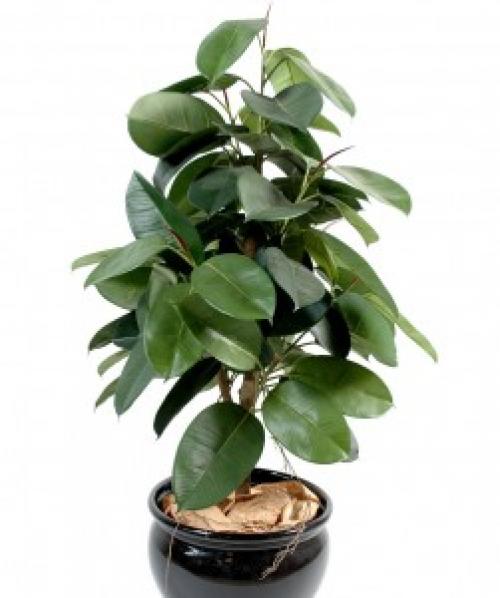

Photo source: flowers.cveti-
How to save a ficus if its last leaves fall and it remains completely naked?
Even when the last leaves of the ficus benjamin fall off, you should not get upset, get discouraged or depressed and hang your nose! Even a tree on which there is not a single leaf has every chance to successfully overgrow with new shoots, thanks to the regenerative function of the function of a living microorganism, the necessary effective preventive and therapeutic measures taken in a timely manner and the ongoing, never-ending efforts to save it.
In order to determine the state of "health" of ficus flowers, you do not need to apply any special efforts, everything is quite simple and banal: if the protrusion of milky juice is visible on the trunk incision and you can feel by touch that the branches are flexible, barely touching them, therefore, the plant alive and the state of his "health" is in perfect order, which means that the owners do not have the slightest cause for concern.
And the ficus is actually a magical flower, homemade, it can fulfill any desires for housekeeping. He helps in building family relationships, maintains the health of the owners of the house. If you want to have a child, bring a ficus into the house, you can already be solid, or, you can, just a twig.
Why do the leaves fall anyway?
Sometimes the methods listed above do not give any results, and the leaves continue to crumble. In this case, the reason for this may be rotten root system... Remove the ficus from the flowerpot, carefully clean the roots from the soil, and inspect them. When they look like gray threads, moreover, they are very slippery, it means that the diagnosis was confirmed. The damaged ficus is transplanted into new soil.
All rotten roots must be cut off, the same applies to dry and dead leaves. Then the root system should be soaked in a solution of potassium permanganate to disinfect it. The cut should dry well, after which you can cover it with foundation, coal powder or ground cinnamon. For transplanting, you will need dry soil. Watering the planted plant during the first days will have to be moderate.
Ficus Benjamin diseases
Cases when leaves turn yellow for natural reasons
Immediately after purchase
Ficus does not tolerate a sharp change in growing conditions and reacts to any stress factors by defoliation, that is, it “dumps ballast” in the form of leaves. In nature, this makes sense, but at home it looks depressing. To help the plant adapt more quickly, transplant it into store-bought ficus potting soil. Be sure to put a good layer of expanded clay drainage on the bottom, check that the holes for the water drain are quite large (at least 1 cm in diameter).
Ficuses love well-drained soil, which allows air to pass through, retains moisture sufficiently, but dries out at the same time, so take care of drainage in advance. It is better to put the pot in a place away from drafts and direct sunlight, but so that the lighting is sufficient. For example, southwest, southeast windows.
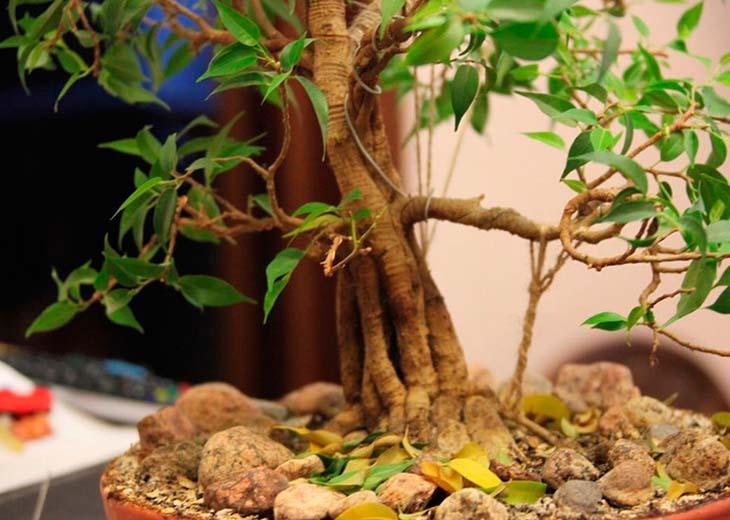

This is especially important for variegated forms, which lose their color without light, and fade in bright light.
Attention! If the tree was purchased in cold, inclement weather and spent some time in the cold, the recovery period may be delayed. When the green pet has acclimated, the crown will begin to grow again.
Be sure to read the rest of the points to know what to do when Benjamin's ficus leaves turn yellow and fall off, and how to avoid it. The notes described below refer to those specimens that have been living in the house for a long time and suddenly began to lose their foliage.
Natural fall of foliage
Ficus tends to lose leaves when changing not only the environment, but also the growing conditions. When the season changes (winter - spring, autumn - winter), when the temperature regime changes, the air becomes drier due to heating or, conversely, humidity increases, natural defoliation can occur. The tree loses a maximum of a dozen leaves per week, but it can be seen that fresh, bright green, healthy leaves are growing.
This is a typical case when Benjamin's ficus starts shedding leaves. Try to keep temperature and humidity as stable as possible during these periods. Do not turn on air conditioners or fans near the plant, cover the heating pipes with a damp cloth. Get used to new conditions gradually.
Another case where defoliation is natural is the exposure of the lower branches and middle tier of an already mature plant. In nature, ficus, like domestic apples and pears, tends to grow upward. As a result, the tree steadily grows its crown on the upper shoots and at the ends of the branches, but the lower tiers become bare and the branches gradually die off. If you don't want to grow an unkempt tree with an ugly crown, try to help the plant.
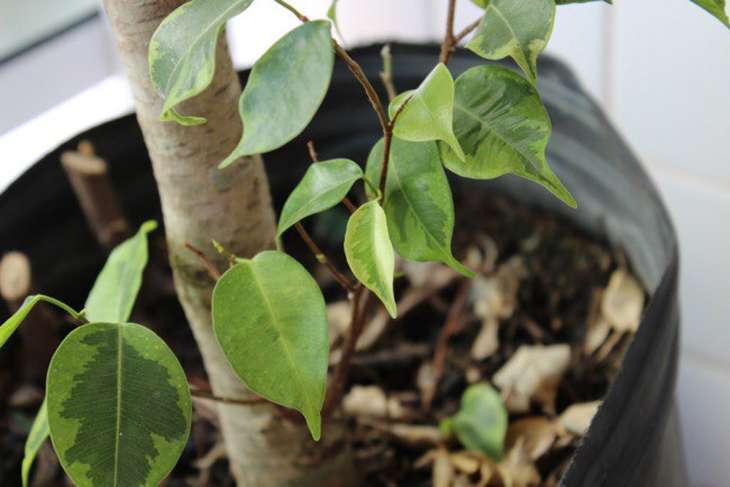

Every year, if necessary, carry out light pruning in early spring: remove the branches that spoil the shape of the crown, cut every third branch at the top into two leaves, every third branch on the middle tier into 4-5 leaves, do not touch the lower ones if they do not spoil the shape. As a result, the tree will begin to grow additional branches, and the crown will become more graceful. Defoliation will cease as the apical shoots will be trimmed and the lower branches will again receive sufficient nourishment.
Aphids and mites
Large and succulent ficus leaves attract many pests. In particular, aphids and spider mites. It is impossible to see microscopic pests with the naked eye. But the traces of their activities are very noticeable and easily recognizable.
Small specks of light color can be seen on the leaves of the plant. At the same time, the ground parts will be covered with numerous thin cobwebs. A ficus affected by a spider mite stops developing and growing, loses its decorative appearance due to yellowed and falling leaves, begins to ache and wither away.
Also, on the back of the leaves, discharge appears, similar to powdery lumps and resinous spots.Affected leaves begin to turn yellow, then die off and fall off. You can get rid of pests thanks to the use of acaricides.
Brief description of ficus Benjamin
This species, along with many other widely cultivated indoor florists, belongs to the Ficus genus of the Mulberry family. In nature, its dimensions can be truly impressive: up to 25 meters in height! It is an evergreen plant that can be found in the Indian subcontinent, China, the northern regions of Australia, Southeast Asia, and the Philippines. In humid climates, it tends to form huge aerial roots and grow, which may even require the protection of nearby structures and communications.
At home, this type of ficus with good care can grow up to 2-3 meters. Its leaves are glossy, with a thin skin, oval in shape, pointed at the top. They can be light, dark green or variegated; grow in width from two to six centimeters, in length - from six to thirteen. Ficus fruits are small syconia, up to two centimeters in diameter, oval or round in shape.
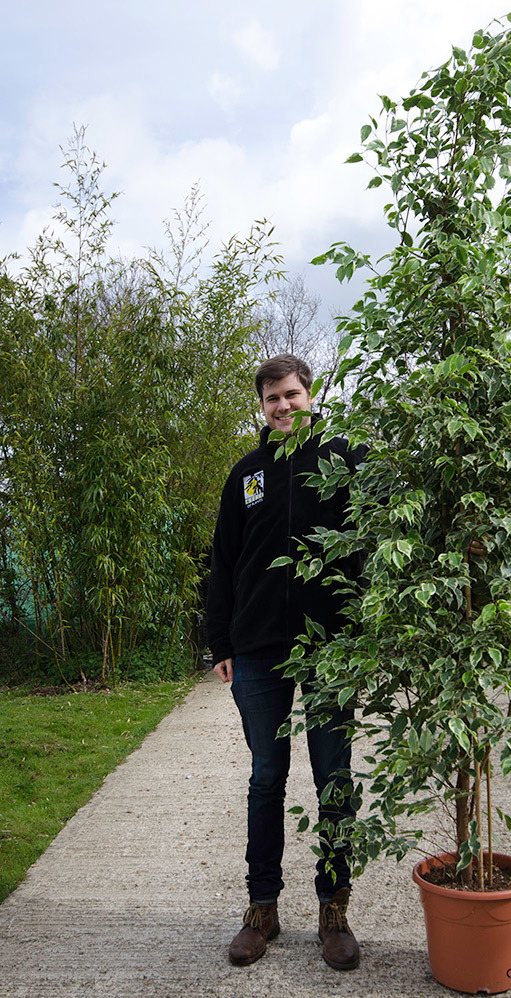

The stem of the Benjamin ficus is erect, the bark is gray. Brown streaks are visible on it. In good conditions, its drooping branches form a wide crown with dense foliage. However, sometimes the owners notice that the leaves of Benjamin's ficus are falling. What to do in this situation? What can provoke it?
Why does Benjamin's ficus throw off its leaves?
In nature, some types of ficuses are deciduous, and with the onset of an unfavorable season, they shed their leaves. There is nothing surprising and unusual in this. But Benjamin's ficus is an evergreen species. Why can he lose leaves at home? There can be several reasons for this phenomenon. Experts point out the following:
- Damage to the plant by pests or diseases.
- Insufficiently comfortable temperature.
- Lack of sunlight.
- Drafts indoors.
- Failure to comply with the recommended irrigation regime and air humidity
- Lack or excess of nutrients, unbalanced feeding.
- A sharp change in the conditions of detention.
Let's consider them further in more detail.
Insufficient lighting
Bright lighting is vital for Benjamin's ficus, although partial shade is also suitable for varieties with monochromatic leaves. This is not surprising, given the range of its distribution in nature. With a lack of light, its leaves become shallow and fall off, the stems become thinner and stretch upward. This happens especially often, naturally, in winter, when natural daylight hours are short. Varieties with variegated leaves (Starlight, Golden King, Reginald) are the hardest to tolerate. Their leaves lose their beautiful color, turn yellow and crumble.
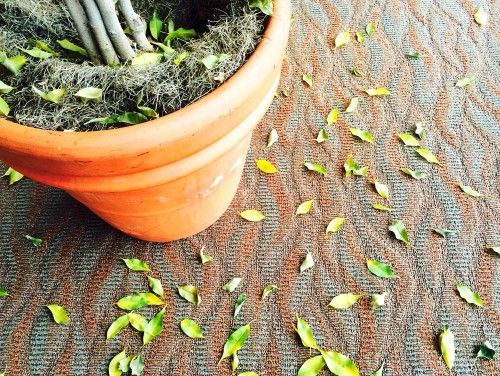

To cope with the problem, it is necessary to carefully rearrange the pot closer to the window, while protecting it from cold air, and better - to organize additional lighting of the ficus with a phytolamp.
Reasons for falling foliage
Ficus Benjamin can shed leaves in the presence of negative factors:
- with a sharp change in temperature;
- if the flower is in a draft;
- spider mite damage due to low humidity;
- insufficient or excessive watering, in which the leaves first turn yellow and then begin to fall off;
- watering with cold tap water;
- frequent change of the location of the flower;
- low room temperature.
- if the leaves are covered with brown spots and began to fall off, the reason may lie in a burn from direct sunlight and low humidity, it is necessary to carry out daily spraying of the crown and shade the flower from the sun;
- if brown spots appeared on the leaves, the flower wilted and began to shed leaves, the problem may be in the low air temperature, in order to prevent it, it is necessary to transfer the ficus to a warmer place or install an additional heating radiator in the room, and the leaves of the plant should not be allowed to come into contact with cold glass window;
- leaves can turn yellow and fall off if there is insufficient nutrition, it is necessary to feed the ficus with mineral fertilizers every month, following the manufacturer's recommendations, overfeeding will burn the roots, and the flower will die.
Read also How to care for bamboo varnishes
If the rules for care are not followed, then the plant will react with yellowed leaves and eventually discard them.
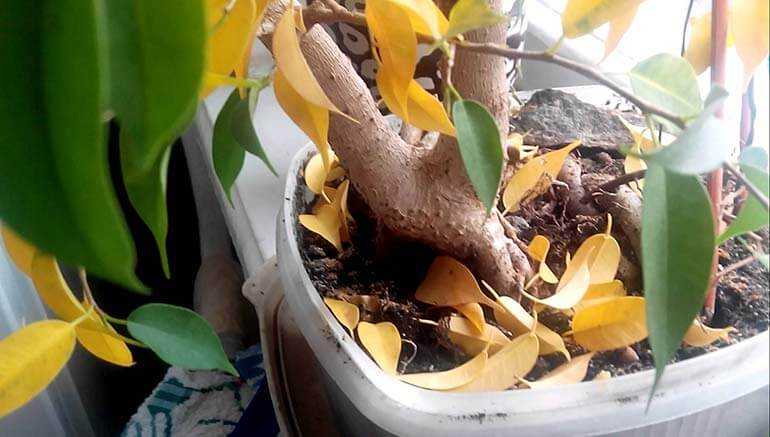

ficus benjamin shedding leaves photo
Attention!
Leaves can be thrown off due to disease or pest infestation of the plant.
How to save a flower?
To reanimate a pet will require diligence in performing some actions:
- Replace potting soil completely.
- Carry out sanitary pruning of dry stems.
- Moisten the trunk and crown in a solution of biofungicide.
- A week after transplanting, add top dressing to the soil.
- Ensure constant admission of fresh air and sunlight.
If leaf fall occurs during the cold season, replace only the topsoil, spray the tree several times a day with a spray bottle, increase the number of light sources and avoid drafts. As soon as spring comes, conduct intensive therapy.
Crown formation
Ficus itself is quite beautiful, but pruning is necessary for it. It stimulates the development of axillary buds from which branches grow. The plant becomes more luxuriant. Ficus Benjamin tolerates pruning well and takes any given shape. To disinfect the pruning shears, it must be treated with alcohol or potassium permanganate. The central shoot must not be cut by more than 20 cm. At least five leaves must remain on it. Side branches can be shortened or removed completely if the crown is too thick. Lack of light can lead to leaf fall. Chopped charcoal is used for sprinkling the slices. To get a stem, you need to remove all the side branches, except for the top five. If the ficus is on the floor, the crown is formed at a height of about one meter. For a desktop stem, shoots are left at a height of 40 cm.
Young ficus needs support, its trunk is very flexible. To form a beautiful composition, several plants are sometimes planted in one pot. Flexible trunks are gradually twisted or intertwined, giving them bizarre shapes. Trellis and support clamps should be loosened as the stems grow.
How to feed when leaves fall
Benjamin sheds leaves if the soil composition is depleted, timely fertilization of the soil is part of the proper care of a houseplant. But you also need to take care not to overfeed the plant, this will badly affect its condition and it will shed its leaves.
Top dressing must be done correctly:
- the dosage should not be overstated, the recommendations on the package must be followed;
- do not feed plants in winter;
- you should not fertilize the soil if the plant has just been transplanted, you need to wait a month;
- fertilizers are not applied to the soil at high air temperatures, for example, on hot summer days;
- do not feed, if the ficus is already dropping leaves due to a dry earthen coma or too abundant watering, you must first eliminate the causes of the leaves falling.
In order not to overfeed the plant, you can use natural formulations in water - charcoal, nettle or mullein. You should also follow the feeding regimen and do this no more than once a week.
Frequently asked questions
Individual leaves began to dry up, what should I do?
Regardless of the type of ficus, avoid direct sunlight. Adhere to the watering regime, in spring and summer - regular, in autumn and winter - limited. The soil should dry out, but not dry out. This will help keep the crown lush and green.
What kind of care does a flower need?
Ficus is bad for change, so you shouldn't change its location. Keep an eye on the comfortable temperature in the room - not lower than 25 ° С in summer, not lower than 16 ° С in winter. Do not leave the plant on a cold windowsill, completely get rid of drafts. Maintain the necessary humidity in the room. Use soft and warm water for irrigation.
After buying a ficus, do I need to transplant it?
Store soil is only suitable for transporting the bush. The transplant should be carried out no earlier than 2-3 weeks after purchase in leafy soil with an acidity of 5.5-6.5 pH. A universal primer is perfect.
Before removing the tree from the transport pot, you need to moisten the soil and carefully remove the root system along with the adhering soil, tap it lightly and place it in a new pot.
Influence of the seasons
Falling leaves can also occur for natural reasons. The lifespan of a leaf is about three years, so sooner or later it will inevitably disappear. And if the phenomenon has not taken on a mass character, you should not panic.
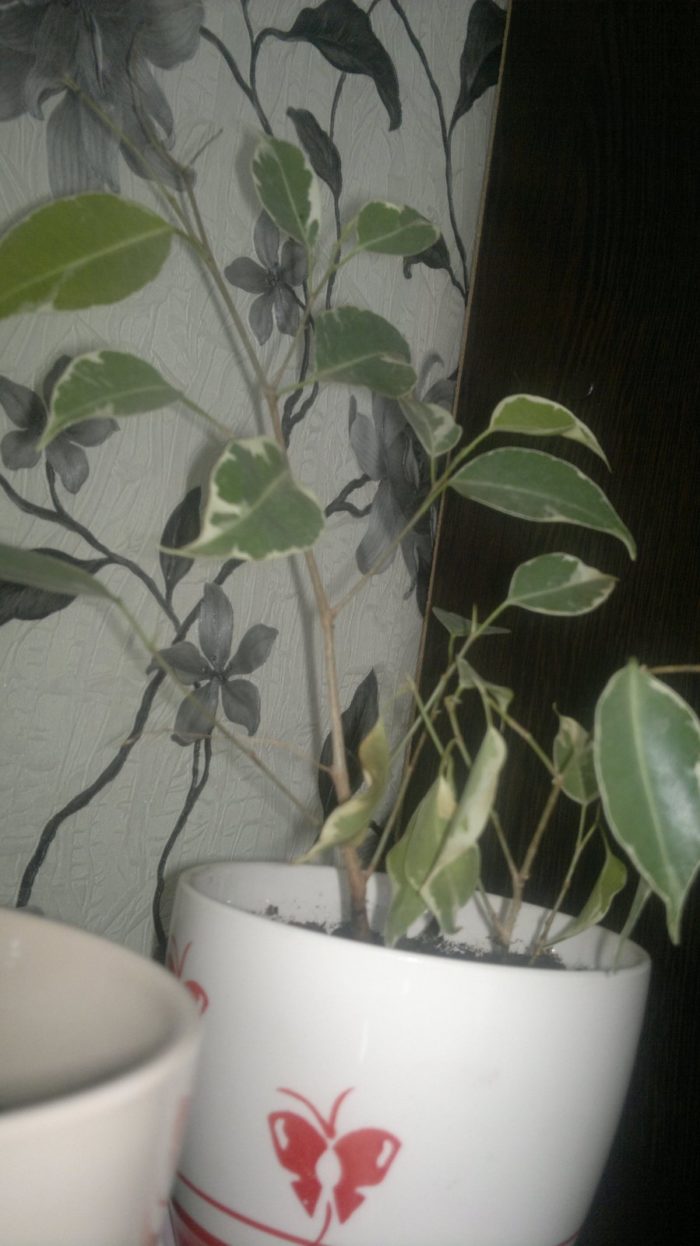

The reasons may be:
- Autumn leaf fall, but not too abundant - a natural natural mechanism of renewal. In the place of the old ones, new leaves will grow in spring.
- In winter, ficus can lose part of the foliage due to temperature differences or lack of light.
- Late autumn and winter are the time of natural rest of the tree, so it is worth leaving it alone, watering and feeding less often. Part of the crown will thin out to renew itself in the spring.
- In the spring, fallen leaves can also indicate a lack of nutrients, the need to add soil, and the time for transplanting is coming.
Feature! As he grows, Benjamin inevitably loses leaves on the lower part of the trunk, giving all his strength to the lush crown. This makes the ornamental plant very similar to its ancestor - a huge tree - in miniature.
Plants always respond to the changing seasons, and ficus is no exception. Be sure to take this into account when growing and look for miscalculations in the content only if the foliage discharge is abnormally large.
Can you save?
A dying plant can be very easily saved if a problem is noticed in time. It is enough to create favorable conditions, give the tree a rest, and it will again start to please the owners.
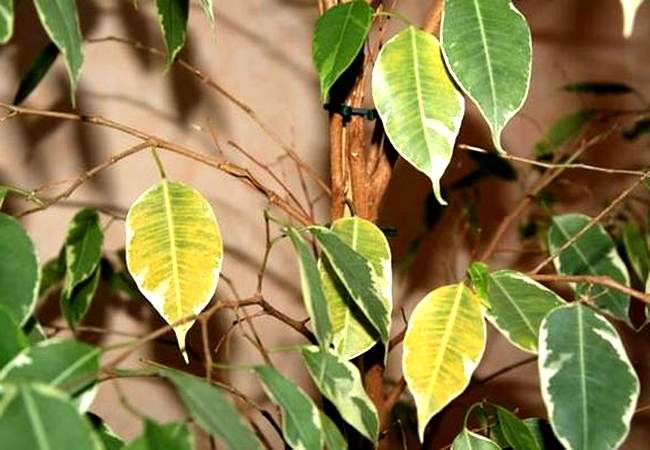

Help:
- changing the angle of illumination;
- temperature normalization;
- watering and spraying with warm water with the addition of preparations for deciduous plants;
- transplanting young and transferring mature plants into new spacious pots.
In advanced cases, it is worthwhile to play it safe and root the layers from the healthiest part. This has to be resorted to if root rot has destroyed most of the root, or the plant is burned with fertilizers.
Plant prevention
It is well known that any problem is easier to prevent than to fix. This also applies to ficus. To avoid leaf fall, it is recommended to take the following preventive measures:
- Observe the correct water regime;
- Keep the plant in a bright place, with a lack of natural light, use artificial;
- Maintain the temperature regime within + 18 + 20 degrees;
- Protect ficus from drafts;
- Plan to replant the plant in a few years;
- Be sure to apply top dressing in spring and summer;
- In the event of a change in the environment (for example, when moving), pre-treat the plant with an anti-stress drug;
- Check the ficus periodically to identify pests;
- Take urgent pest and disease control measures.
From the video you will learn how to properly care for Benjamin's ficus in the spring so that it does not shed its leaves.
How to reanimate?
Urgent measures to save the plant are carried out when the crown is completely bare, the branches have dried up and break, life barely glimmers in the trunk. What should be done:
- Reinforced watering with warm rainwater, top dressing every 3-5 days, if the plant is forgotten to water in a timely manner.
- Transplant if the soil is incorrectly selected, or the soil is completely depleted.
- Pruning of all branches thickening the crown, removing unsettled leaves and transferring to a cool, darkened room for several days. These measures help to stimulate the growth of new shoots in case of mechanical damage and severe damage by pests and diseases.


Often, flower growers try to remove the entire table, leaving a 10–15 cm "stump" if the entire tree cannot be saved. After some time, the culture will throw out a new young strong shoot, which will grow into a beautiful tree.
Waterlogging becomes a common cause of root rot - this is almost the only disease in which the chances of salvation are close to zero. A rotten root collar, completely decayed roots with still living shoots - an excuse to cut and root several new cuttings so that Benjamin remains in the collection.
Lack or excess of nutrients, unbalanced feeding
The soil, poor in micro- and macroelements necessary for the plant, does not allow the ficus to fully grow and develop. Lack of nutrients and insufficient feeding can lead to crushing and loss of leaves, which the plant will simply not be able to feed properly.
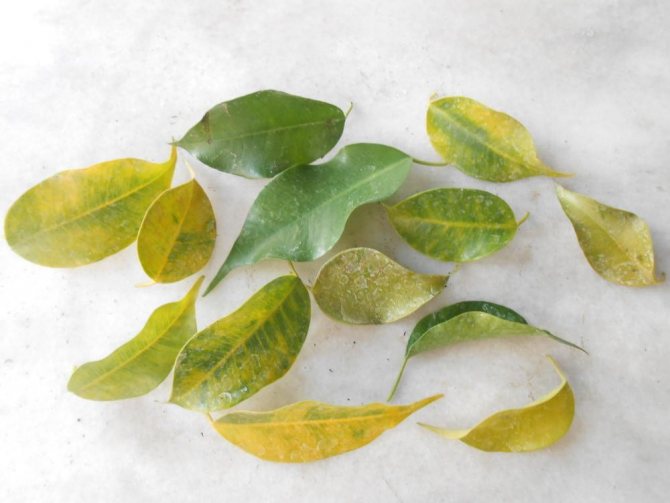

As for improper fertilization, experts speak of this reason for foliage falling as very common, especially among inexperienced growers. So, the use of dressings in larger quantities than necessary, in greater concentration, especially - the introduction of dry fertilizers directly into the soil, without dilution, can lead to sad consequences and even cause burns to the roots. It should be understood that any fertilizer in excess of the recommended dose becomes poison. In this situation, the plant will begin to lose leaves and may die.
Description of the plant
This native of hot countries - India, China, Australia, the Philippines - grows up to 20 meters under natural conditions. At home, specimens of more than 3 meters are rarely found. It is a shrub or tree with gray bark, drooping branches and oblong leaves.
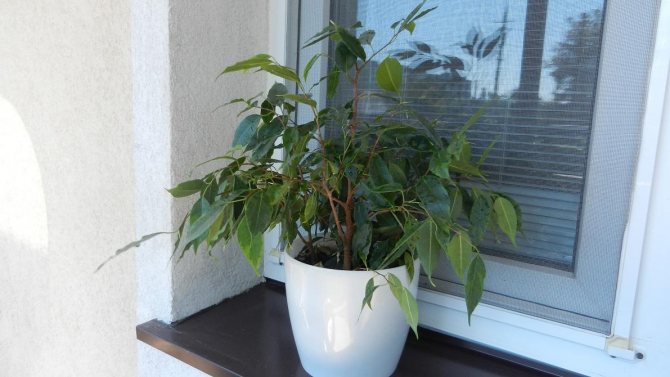

Their color varies from variegated to monochromatic, there are also specimens with edging foliage. The leaves are straight, wavy, slightly curled in shape. The cute fruits of such a plant are not eaten. According to the Feng Shui beliefs, the ficus in the room purifies the air and makes the atmosphere comfortable. Promotes sobriety, helps you focus and work as efficiently as possible.
Prevention of leaf fall
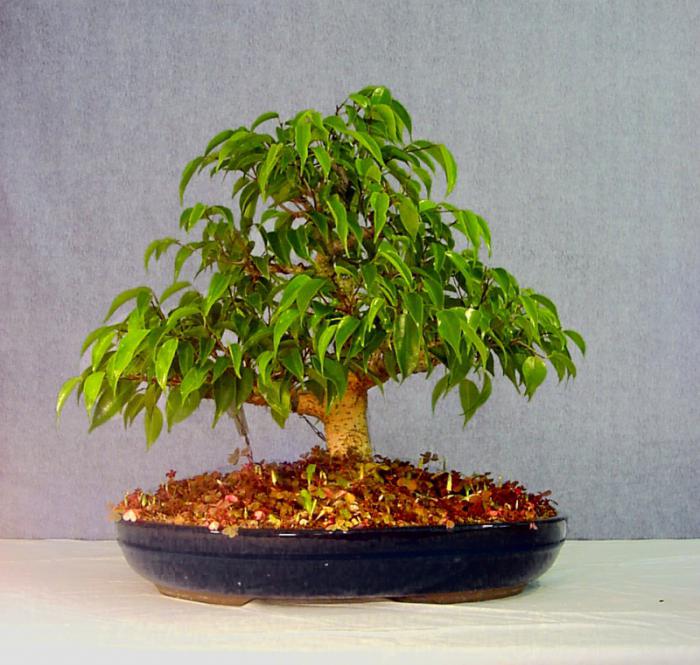

So, so that such a trouble does not happen with Benjamin's ficus, the following conditions must be met:
- the plant must have a permanent place;
- the optimum temperature should be maintained, sufficient air humidity should be observed;
- there should be good drainage and moderate watering.
Despite the capricious nature, Benjamin's ficus does not lose popularity, because it is able to decorate an exquisite winter garden or greenhouse, as well as the interior of any room.


